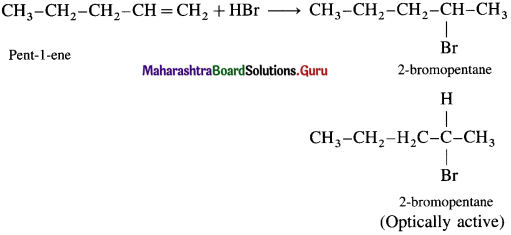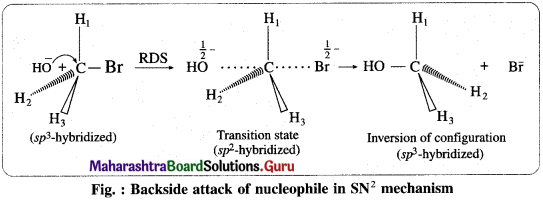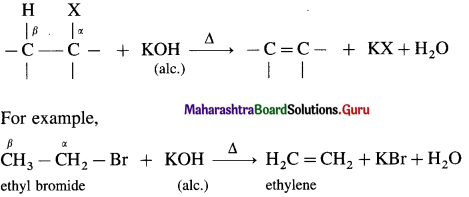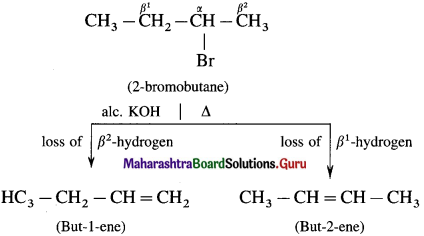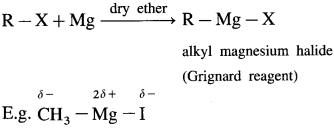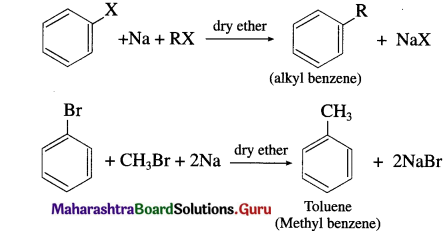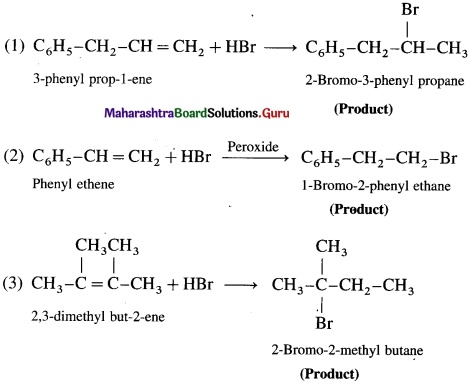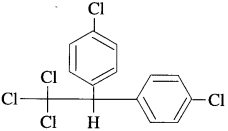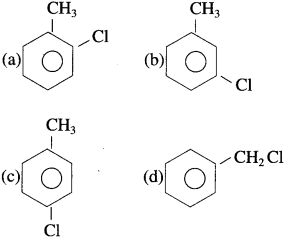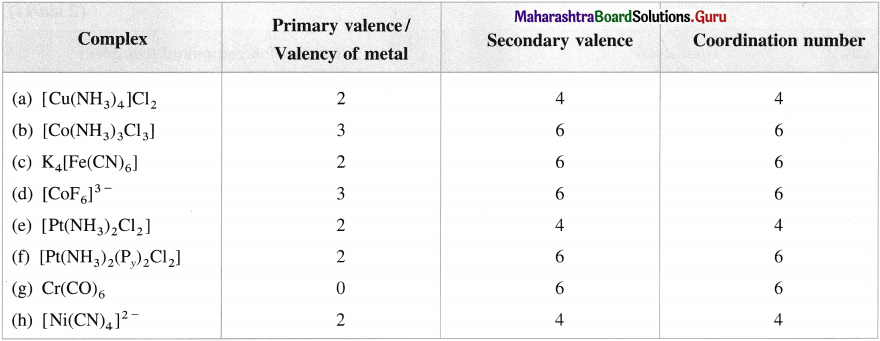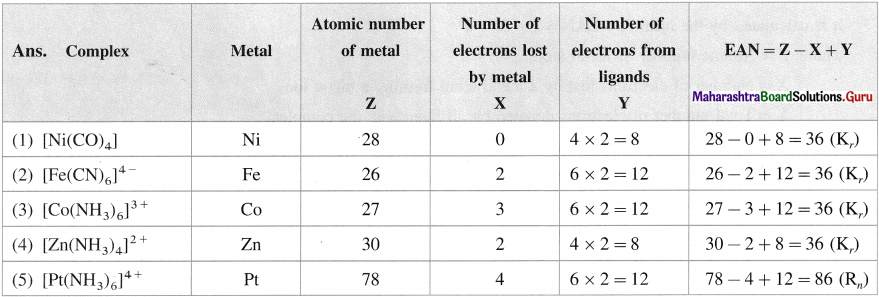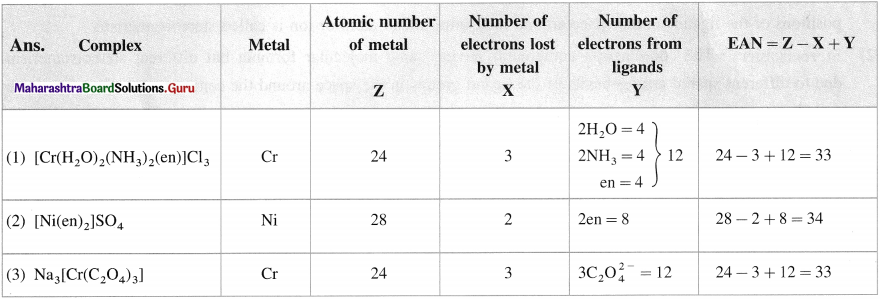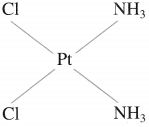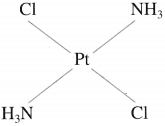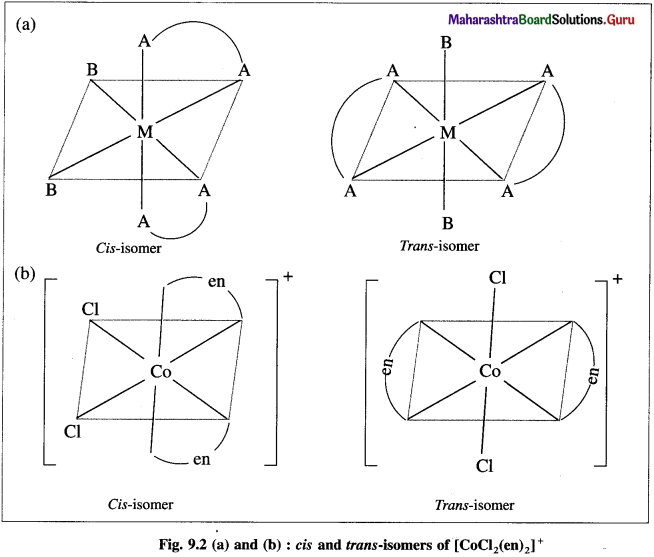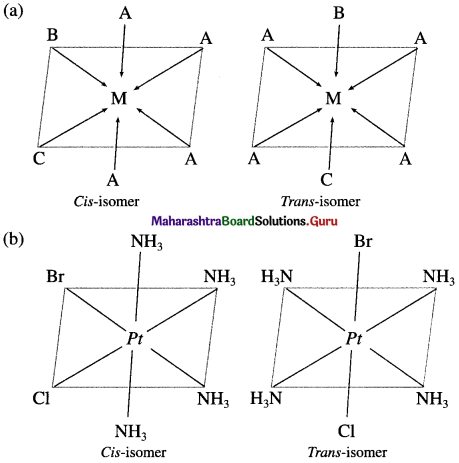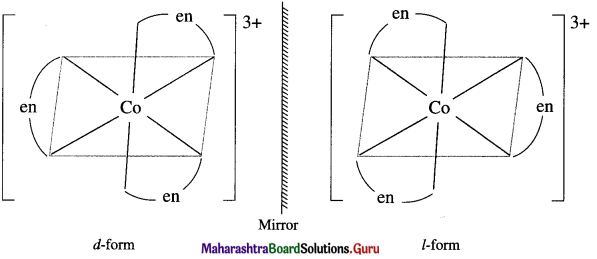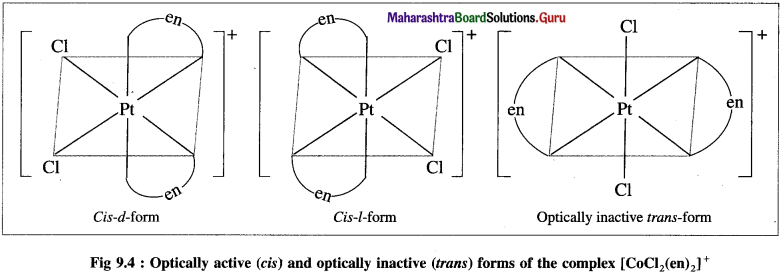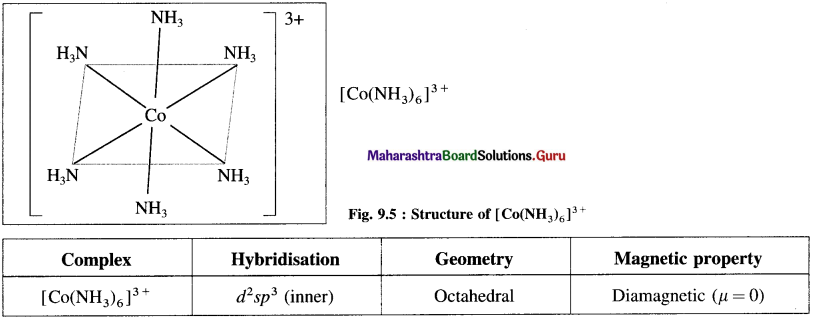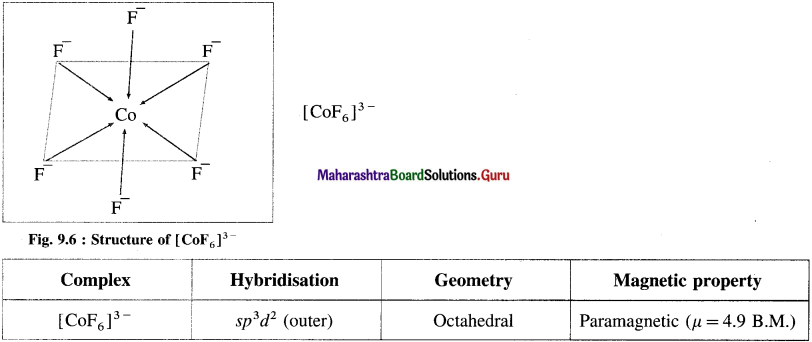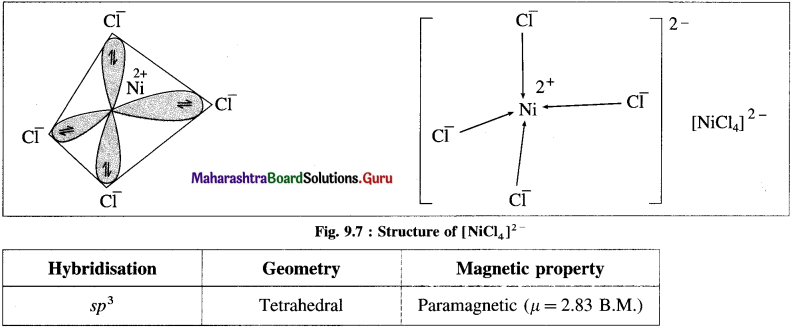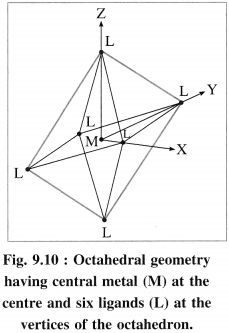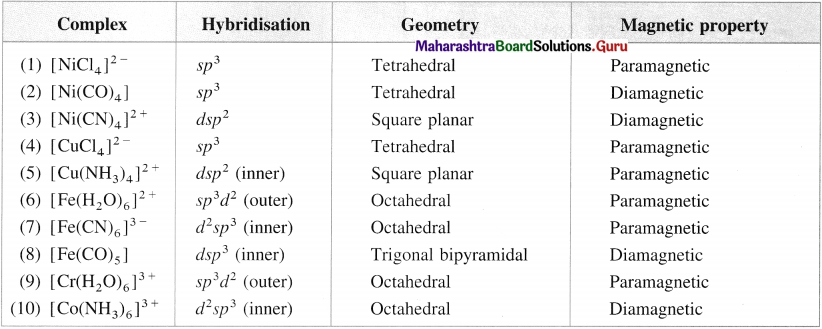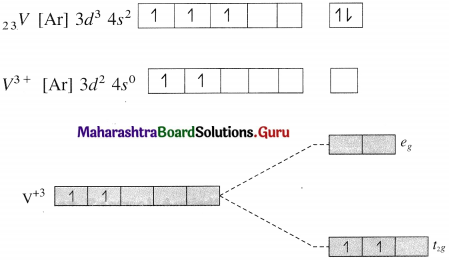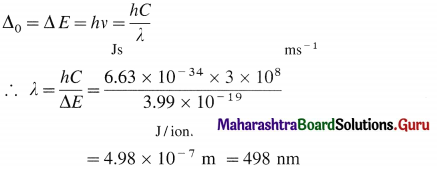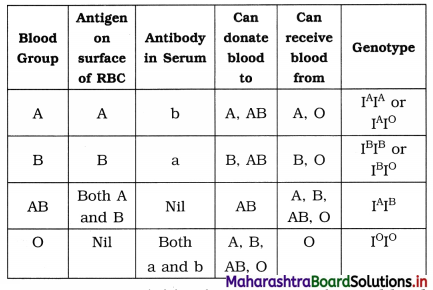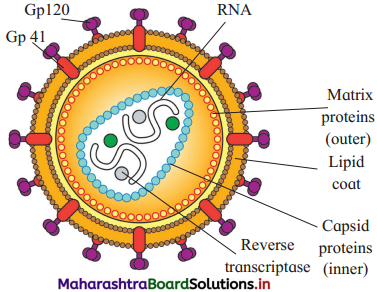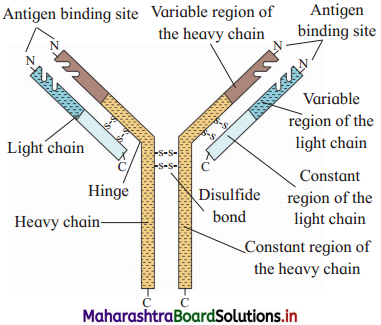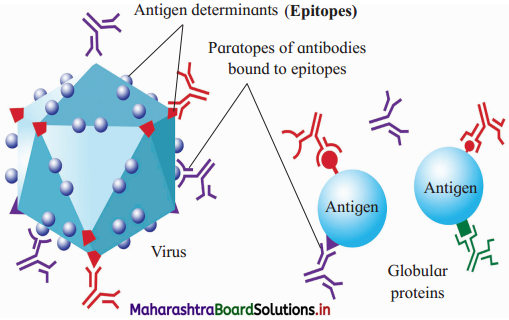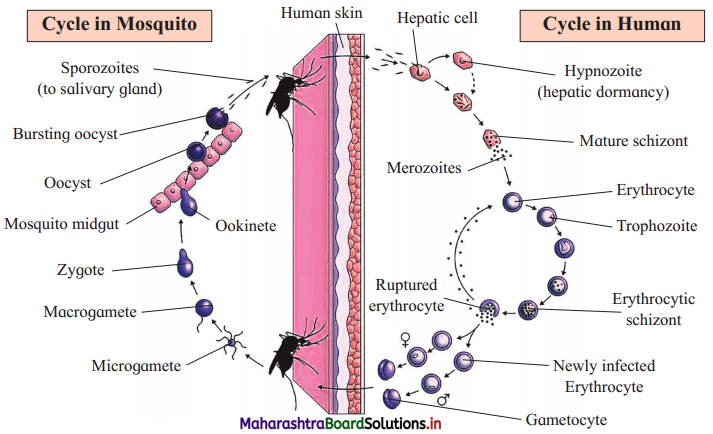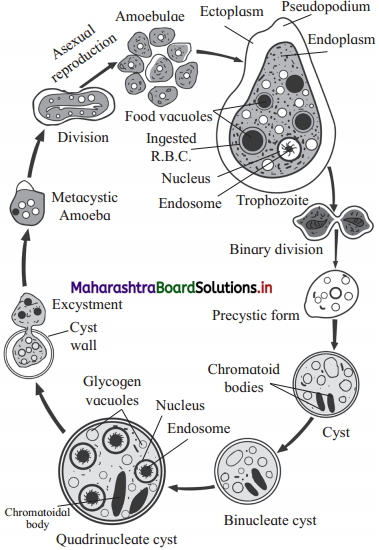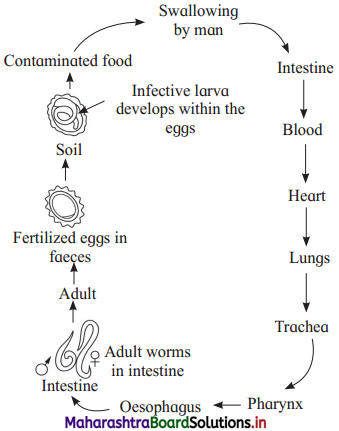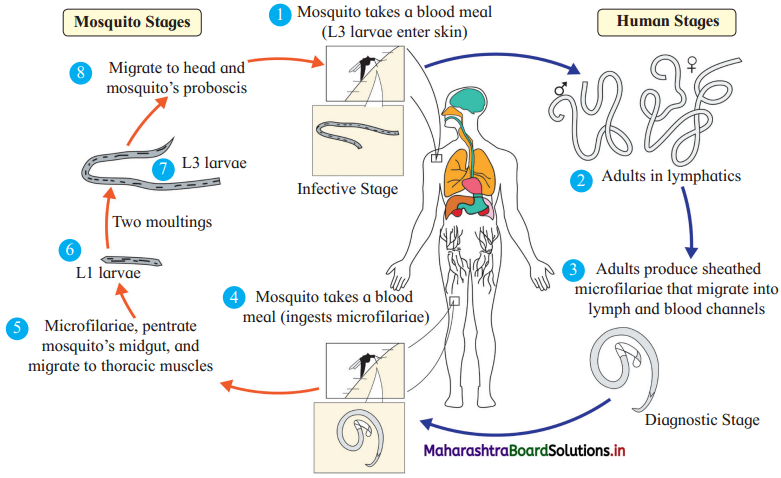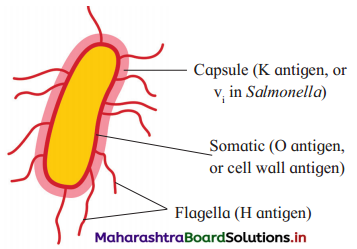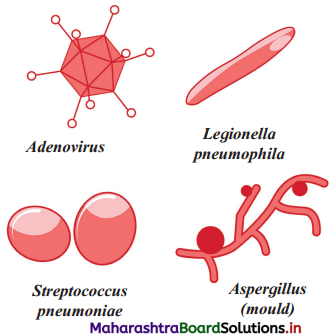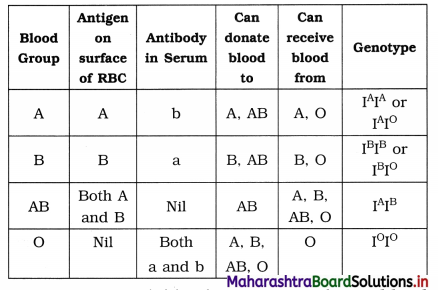Balbharti Maharashtra State Board 12th Biology Important Questions Chapter 9 Control and Co-ordination Important Questions and Answers.
Maharashtra State Board 12th Biology Important Questions Chapter 9 Control and Co-ordination
Multiple choice questions
Question 1.
The supporting cells that produce myelin sheath in the CNS are ……………….
(a) Oligodendrocytes
(b) Satellite cells
(c) Astrocytes
(d) Schwann cells
Answer:
(a) Oligodendrocytes
Question 2.
Human brain develops to its full size at an age of year/s.
(a) 1
(b) 6
(c) 12
(d) 18
Answer:
(b) 6

Question 3.
Telencephalon is the other name of ……………….
(a) pons varolii
(b) medulla oblongata
(c) cerebrum
(d) cerebellum
Answer:
(c) cerebrum
Question 4.
Olfactory tracts merge in olfactory area of lobe.
(a) Frontal
(b) Parietal
(c) Occipital
(d) Temporal
Answer:
(d) Temporal
Question 5.
………………. is the largest commissure of the human brain.
(a) Corpora striata
(b) Corpora quadrigemina
(c) Habencular commissure
(d) Corpus callosum
Answer:
(d) Corpus callosum
Question 6.
Grey matter of the brain shows large collection of ……………….
(a) dendrons
(b) cytons
(c) axons
(d) synapsis
Answer:
(b) cytons
Question 7.
Masses of grey matter in white matter of the cerebrum are called ……………….
(a) corpora striata
(b) corpus callosum
(c) paracoel
(d) basal ganglia
Answer:
(d) basal ganglia
Question 8.
Parietal and temporal lobes of cerebrum are separated by sulcus.
(a) lateral
(b) parieto occipital
(c) central
(d) median longitudinal
Answer:
(a) lateral
Question 9.
……………… area is motor speech area
(a) Acoustic
(b) Wernike’s
(c) Somato sensory
(d) Broca’s
Answer:
(d) Broca’s
Question 10.
Maxillary nerve is a branch of nerve.
(a) Occulomotor
(b) Trochlear
(c) Trigeminal
(d) Facial
Answer:
(c) Trigeminal
Question 11.
Spinal accessory is the cranial nerve.
(a) IV
(b) VI
(c) IX
(d) XI
Answer:
(d) XI
Question 12.
Rotation of eye ball is controlled by ……………….
(a) Optic nerve
(b) Pathetic nerve
(c) Auditory nerve
(d) Hypoglossal nerve
Answer:
(b) Pathetic nerve
Question 13.
The spinal nerves emerge out of vertebral column through ……………….
(a) intervertebral foramina
(b) neural canal
(c) central canal
(d) foramen magnum
Answer:
(a) intervertebral foramina
Question 14.
The neuro transmitter is removed by an enzyme called ……………….
(a) noradrenaline
(b) acetylcholine
(c) hyaluronidase
(d) cholinesterase
Answer:
(d) cholinesterase
Question 15.
The reflex action originates in ……………….
(a) sensory neuron
(b) motor neuron
(c) receptor organ
(d) effector organ
Answer:
(c) receptor organ
Question 16.
Cytons of neurons are located in dorsal root ganglion.
(a) afferent
(b) efferent
(c) adjustor
(d) association
Answer:
(a) afferent
Question 17.
Wall of carotid arteries contain ……………….
(a) thermoreceptors
(b) mechanoreceptors
(c) baroreceptors
(d) statoacoustic receptors
Answer:
(c) baroreceptors
Question 18.
The electronegativity inside the membrane is due to ……………….
(a) less anions than cations
(b) less cations than anions
(c) bicarbonates
(d) carbonates
Answer:
(b) less cations than anions
Question 19.
The neuro transmitters stimulate ……………….
(a) presynaptic membrane
(b) cyton
(c) axon terminals
(d) postsynaptic membrane
Answer:
(d) postsynaptic membrane
Question 20.
………………. is an extero-receptor.
(a) Thermoreceptor
(b) Baroreceptor
(c) Proprioreceptor
(d) Enteroreceptor
Answer:
(a) Thermoreceptor
Question 21.
The are described as windows for brain.
(a) sensory neurons
(b) motor neurons
(c) effectors
(d) sense organs
Answer:
(d) sense organs
Question 22.
Otolith organ is formed of ……………….
(a) cochlea and vestibule
(b) sacculus and utriculus
(c) semicircular canals
(d) ear ossicles
Answer:
(b) sacculus and utriculus
Question 23.
Olfactory bulbs are extensions of brain’s ……………….
(a) cerebrum
(b) limbic system
(c) RAS
(d) pons varolii
Answer:
(b) limbic system
Question 24.
Gustatory senses are noted by ……………….
(a) retina
(b) skin
(c) nose
(d) tongue
Answer:
(d) tongue
Question 25.
………………. is attached to the eardrum.
(a) Malleus
(b) Incus
(c) Stapes
(d) Cochlea
Answer:
(a) Malleus
Question 26.
Eustachian tube is present in ……………….
(a) external ear
(b) internal ear
(c) heart
(d) middle ear
Answer:
(d) middle ear
Question 27.
The internal ear is a fluid filled structure called ……………….
(a) cochlea
(b) vestibule
(c) labyrinth
(d) otolith
Answer:
(c) labyrinth
Question 28.
The space within cochlea is known as ……………….
(a) scala vestibule
(b) scala tympani
(c) aqueous chamber
(d) scala media
Answer:
(d) scala media
Question 29.
Thermoregulatory centre in the body is ……………….
(a) hypothalamus
(b) cerebellum
(c) spinal cord
(d) pituitary
Answer:
(a) hypothalamus

Question 30.
Which of the following is a sensory nerve?
(a) Vagus
(b) Auditory
(c) Facial
(d) Lumbar
Answer:
(b) Auditory
Question 31.
Chemical transmission in synapse occurs due to ……………….
(a) cholesterol
(b) ADH
(c) acetylcholine
(d) cholinesterase
Answer:
(c) acetylcholine
Question 32.
Voluntary muscular coordination is under the control of ……………….
(a) medulla
(b) pons
(c) hypothalamus
(d) cerebrum
Answer:
(d) cerebrum
Question 33.
All involuntary vital activities are under the control of ……………….
(a) medulla oblongata
(b) cerebellum
(c) cerebral hemispheres
(d) pons Varolii
Answer:
(a) medulla oblongata
Question 34.
Cerebellum is controlling centre for ……………….
(a) muscular strength
(b) memory
(c) equilibrium
(d) muscular coordination
Answer:
(c) equilibrium
Question 35.
Which receptors are present in the retina?
(a) Chemoreceptors
(b) Thermoreceptors
(c) Photoreceptors
(d) Baroreceptors
Answer:
(c) Photoreceptors
Question 36.
Breathing is controlled by ……………….
(a) trachea
(b) medulla oblongata
(c) lungs
(d) hypothalamus
Answer:
(b) medulla oblongata
Question 37.
Corpus callosum is a nerve fibre bridge which connects ……………….
(a) two cerebral hemispheres
(b) cerebrum and cerebellum
(c) cerebellum and medulla
(d) midbrain and hindbrain
Answer:
(a) two cerebral hemispheres
Question 38.
Centre for thirst and hunger are located in ……………….
(a) cerebrum
(b) cerebellum
(c) hypothalamus
(d) medulla
Answer:
(c) hypothalamus
Question 39.
Gyri in the brain are present in ……………….
(a) cerebral cortex
(b) olfactory lobes
(c) medulla oblongata
(d) hypothalamus
Answer:
(a) cerebral cortex
Question 40.
Which of the following is a structure of mesencephalon?
(a) Inferior colliculi
(b) Thalamus
(c) Cerebellum
(d) Pons varolii
Answer:
(a) Inferior colliculi
Question 41.
Third ventricle lies in ……………….
(a) midbrain
(b) forebrain
(c) cerebellum
(d) medulla oblongata
Answer:
(b) forebrain
Question 42.
Medulla oblongata encloses ……………….
(a) third ventricle
(b) fourth ventricle
(c) first ventricle
(d) second ventricle
Answer:
(b) fourth ventricle
Question 43.
Loss of memory may result from injury to the ……………….
(a) corpora quadrigemina
(b) pons varolii
(c) cerebellum
(d) cerebrum
Answer:
(d) cerebrum
Question 44.
Terminal non-nervous part of spinal cord is ……………….
(a) funiculus
(b) filum terminale
(c) cauda equina
(d) conus terminalis
Answer:
(b) filum terminale
Question 45.
Which part of the pituitary is neurohaemal organ?
(a) Pars distalis
(b) Infundibulum
(c) Pars nervosa
(d) Pars intermedia
Answer:
(c) Pars nervosa
Question 46.
Development of secondary sexual characteristics in female is under the control of ……………….
(a) growth hormone
(b) TSH
(c) estrogen
(d) progesterone
Answer:
(c) estrogen
Question 47.
Hypersecretion of STH in children causes ……………….
(a) cretinism
(b) gigantism
(c) dwarfism
(d) myxoedema
Answer:
(b) gigantism
Question 48.
Milk secretion in lactating woman is controlled by ……………….
(a) LH
(b) prolactin
(c) relaxin
(d) oestrogen
Answer:
(b) prolactin
Question 49.
ADH is secreted by
(a) adrenal gland
(b) thyroid
(c) hypothalamus
(d) pancreas
Answer:
(c) hypothalamus
Question 50.
BMR is increased by the administration of ……………….
(a) insulin
(b) GH
(c) thyroxine
(d) testosterone
Answer:
(c) thyroxine
Question 51.
The largest endocrine gland in the body is ……………….
(a) pituitary
(b) adrenal
(c) liver
(d) thyroid
Answer:
(d) thyroid
Question 52.
Diabetes insipidus is caused by the deficiency of ……………….
(a) calcitonin
(b) oxytocin
(c) atrial natriuretic factor
(d) vasopressin
Answer:
(d) vasopressin
Question 53.
Simple goitre is caused by the deficiency of ……………….
(a) TSH
(b) thyrocalcitonin
(c) thyroxine
(d) iodine
Answer:
(d) iodine
Question 54.
Exopthalmic goitre is also known as ……………….
(a) Grave’s disease
(b) Gull’s disease
(c) Simple goitre
(d) Cushing’s disease
Answer:
(a) Grave’s disease
Question 55.
Cushing’s syndrome is developed due to ……………….
(a) hyposecretion of ACTH
(b) hypersecretion of corticoids
(c) hyposecretion of thyroxine
(d) hypersecretion of thyroxine
Answer:
(b) hypersecretion of corticoids

Question 56.
Pituitary gland is under the control of ……………….
(a) thyroid
(b) adrenal
(c) pineal
(d) hypothalamus
Answer:
(d) hypothalamus
Question 57.
FSH is secreted by ……………….
(a) pituitary gland
(b) thyroid gland
(c) ovary
(d) adrenal gland
Answer:
(a) pituitary gland
Question 58.
ICSH stimulates ……………….
(a) ovary
(b) Leydig cells
(c) seminiferous tubules
(d) kidney
Answer:
(b) Leydig cells
Question 59.
Which of the following secrete LH ?
(a) Pituitary
(b) Thyroid
(c) Ovary
(d) Adrenal
Answer:
(a) pituitary
Question 60.
TSH regulates secretion.
(a) thyroxine
(b) MSH
(c) androgens
(d) insulin
Answer:
(a) thyroxine
Question 61.
Deficiency of thyroxine in adults cause ……………….
(a) cretinism
(b) myxoedema
(c) diabetes
(d) Cushing’s disease
Answer:
(b) myxoedema
Question 62.
Osmotic pressure and blood pressure are maintained by ……………….
(a) glucocorticoids
(b) aldosterone
(c) TRF
(d) MSH
Answer:
(b) aldosterone
Question 63.
Hormone secreted by corpus luteum is ……………….
(a) aldosterone
(b) progesterone
(c) testosterone
(d) cortisol
Answer:
(b) progesterone
Question 64.
………………. is also called hypophyseal stalk.
(a) Infundibulum
(b) Median eminence
(c) Pars intermedia
(d) Sphenoid bone
Answer:
(a) infundibulum
Question 65.
………………. is like a collar around hypophyseal stalk.
(a) Pars distalis
(b) Pars nervosa
(c) Pars intermedia
(d) Pars tuberalis
Answer:
(d) Pars tuberalis
Question 66.
Herring bodies are the parts of ……………….
(a) hypothalamo-hypophyseal tracts
(b) pituicytes
(c) hypothalamo-hypophyseal portal system
(d) pituitary cleft
Answer:
(a) hypothalamo-hypophyseal tracts
Question 67.
Corticotropin is the other name of ……………….
(a) ACTH
(b) STH
(c) Aldosterone
(d) ADH
Answer:
(a) ACTH
Question 68.
Adrenal failure leads to ……………….
(a) Acromegaly
(b) Simmond’s disease
(c) Midget
(d) Addison’s disease
Answer:
(d) Addison’s disease
Question 69.
Prolactin inhibiting factor is secreted by ……………….
(a) Hypophysis
(b) Hypothalamus
(c) Thyroid
(d) Mammary glands
Answer:
(b) Hypothalamus
Question 70.
Which one of the following is not applicable to prolactin ?
(a) Mammotropin
(b) Lactogenic hormone
(c) Somatotropin
(d) Luteotropin
Answer:
(c) Somatotropin
Question 71.
………………. is a gonadotropic hormone.
(a) STH
(b) LTH
(c) ACTH
(d) FSH
Answer:
(d) FSH
Question 72.
Rhythmic integrated contractions of jejunum are controlled by ……………….
(a) coherin
(b) insulin
(c) glucagon
(d) ADH
Answer:
(a) coherin
Question 73.
Thyroid gland is derived from of embryo.
(a) ectoderm
(b) mesoderm
(c) endoderm
(d) ecto-endoderm
Answer:
(c) endoderm
Question 74.
Deficiency of thyroxine in infants causes ……………….
(a) Cretinism
(b) Grave’s disease
(c) Myxoedema
(d) Exophthalmos
Answer:
(a) Cretinism .
Question 75.
………………. is a hypercalcemic hormone.
(a) PTH
(b) TCT
(c) Thyroxine
(d) ACTH
Answer:
(a) PTH
Question 76.
………………. is a middle layer of adrenal cortex.
(a) Zona fasciculata
(b) Zona pellicida
(c) Zona glomerulosa
(d) Zona reticularis
Answer:
(a) Zona fasciculata
Question 77.
Decrease in the blood calcium level is ……………….
(a) hyperglycemia
(b) hypercalcemia
(c) hypoglycemia
(d) hypocalcemia
Answer:
(d) hypocalcemia
Question 78.
………………. stimulates RBC production.
(a) Aldosterone
(b) Cortisol
(c) Epinephrine
(d) Parathormone
Answer:
(b) Cortisol
Question 79.
Chemicals which are released at the synaptic junction are called ……………….
(a) hormones
(b) neurotransmitters
(c) cerebrospinal fluid
(d) lymph
Answer:
(b) neurotransmitters
Question 80.
Potential difference across resting membrane is negatively charged. This is due to differential distribution of the following ions.
(a) Na+ and K+ ions
(b) Ca++ and Cl– ions
(c) Ca++ and Mg++ ions
(d) Mg++ and Cl– ions
Answer:
(a) Na+ and K+ ions
Question 81.
Which of the following is not involved in Knee-jerk reflex?
(a) Muscle spindle
(b) Motor neuron
(c) Brain
(d) Inter neurons
Answer:
(c) Brain
Question 82.
An area in the brain which is associated with strong emotions is ……………….
(a) Cerebral cortex
(b) Cerebellum
(c) Limbic system
(d) Medulla
Answer:
(c) Limbic system
Question 83.
Which is the vitamin present in Rhodopsin?
(a) Vitamin A
(b) Vitamin B
(c) Vitamin C
(d) Vitamin D
Answer:
(a) Vitamin A
Question 84.
Wax gland present in the ear canal is modified ……………….
(a) Sweat gland
(b) Vestibular gland
(c) Cowper’s gland
(d) Sebaceous gland
Answer:
(d) Sebaceous gland
Question 85.
The part of internal ear responsible for hearing is ……………….
(a) cochlea
(b) semicircular canal
(c) utriculus
(d) sacculus
Answer:
(a) cochlea
Question 86.
The organ of corti is a structure present in ……………….
(a) external ear
(b) middle ear
(c) semi circular canal
(d) cochlea
Answer:
(d) cochlea
Question 87.
Select the right match of endocrine gland and their hormones among the options given below.
A. Pineal i. Epinephrine
B. Thyroid ii. Melatonin
C. Ovary iii. Estrogen
D. Adrenal medulla iv. Tetraiodothyronine
(a) A-iv, B-ii, C-iii, D-i
(b) A-ii, B-iv, C-i, D-iii
(c) A-iv, B-ii, C-i, D-iii
(d) A-ii, B-iv, C-iii, D-i
Answer:
(d) A-ii, B-iv, C-iii, D-i
Question 88.
Listed below are the hormones of anterior pituitary origin. Tick the wrong entry.
(a) Growth hormone
(b) FSH
(c) Oxytocin
(d) ACTH
Answer:
(c) Oxytocin
Question 89.
Mary is about to face an interview. But during the first five minutes before the interview she experiences sweating, increased rate of heartbeat, respiration, etc. Which hormone is responsible for her restlessness?
(a) Estrogen and progesterone
(b) Oxytocin and vasopressin
(c) Adrenaline and noradrenaline
(d) Insulin and glucagon
Answer:
(c) Adrenaline and noradrenaline
Question 90.
The steroid responsible for balance of water and electrolytes in our body is ……………….
(a) Insulin
(b) Melatonin
(c) Testosterone
(d) Aldosterone
Answer:
(d) Aldosterone
Question 91.
Thymosin is responsible for ……………….
(a) raising the blood sugar level
(b) raising the blood calcium level
(c) increased production of T lymphocytes
(d) decrease in blood RBC
Answer:
(c) increased production of T lymphocytes
Question 92.
In the mechanism of action of a protein hormone, one of the second messengers is ……………….
(a) Cyclic AMP
(b) Insulin
(c) T3
(d) Gastrin
Answer:
(a) Cyclic AMP

Question 93.
Leydig cells produce a group of hormones called ……………….
(a) androgens
(b) estrogen
(c) aldosterone
(d) gonadotropins
Answer:
(a) androgens
Question 94.
Corpus luteum secretes a hormone called ……………….
(a) prolactin
(b) progesterone
(c) aldosterone
(d) testosterone
Answer:
(b) progesterone
Question 95.
Cortisol is secreted from ……………….
(a) pancreas
(b) thyroid
(c) adrenal
(d) thymus
Answer:
(c) adrenal
Question 96.
A hormone responsible for normal sleep – wake cycle is ……………….
(a) epinephrine
(b) gastrin
(c) melatonin
(d) insulin
Answer:
(c) melatonin
Question 97.
Match the pairs and choose the correct answer among the following options.
A. Epinephrine
i. Increase in muscle growth
B. Testosterone
ii. Decrease in blood pressure
C. Glucagon
iii. Decrease in liver glycogen content
D. Atrial natriuretic factor
iv. Increase in heartbeat
(a) A-ii, B-i, C-iii, D-iv
(b) A-iv, B-i, C-iii, D-ii
(c) A-i, B-ii, C-iii, D-iv
(d) A-i, B-iv, C-ii, D-iii
Answer:
(b) A-iv, B-i, C-iii, D-ii
Question 98.
Blood calcium level is a resultant of how much dietary calcium is absorbed, how much calcium is lost in the urine, how much bone dissolves releasing calcium into the blood and how much calcium from blood enters tissues. Several factors play an important role in these processes. Mark the one which has no role.
(a) Vitamin D
(b) Parathyroid hormone
(c) Thyrocalcitonin
(d) Thymosin
Answer:
(d) Thymosin
Question 99.
All the following tissues in mammals except one consists of a central ‘medullary’ region surrounded by a cortical region. Mark the wrong entry.
(a) Ovary
(b) Adrenal
(c) Liver
(d) Kidney
Answer:
(c) Liver
Match the columns
Question 1.
Match the hormones with their source
| Column A |
Column B |
| (1) Glucagon |
(i) Neurohypophysis |
| (2) Adrenaline |
(ii) Islets of Langerhans |
| (3) Somato tropins |
(iii) Adenohypophysis |
| (4) ADH |
(iv) Medulla |
Answer:
| Column A |
Column B |
| (1) Glucagon |
(ii) Islets of Langerhans |
| (2) Adrenaline |
(iv) Medulla |
| (3) Somato tropins |
(iii) Adenohypophysis |
| (4) ADH |
(i) Neurohypophysis |
Question 2.
Match the layer of adrenal with its hormone.
| Column A (Layers of adrenal cortex) |
Column B (Hormones) |
| (1) Zona glomerulosa |
(A) Cortisols |
| (2) Zona fasciculata |
(B) Androgens |
| (3) Zona reticularis |
(C) Aldosterone |
Answer:
| Column A (Layers of adrenal cortex) |
Column B (Hormones) |
| (1) Zona glomerulosa |
(C) Aldosterone |
| (2) Zona fasciculata |
(A) Cortisols |
| (3) Zona reticularis |
(B) Androgens |
Question 3.
Match the disorder with the gland associated with it.
| Column A (Disorder) |
Column B (Associated Gland) |
| (1) Addison’s disease |
(A) Hypothalamus |
| (2) Grave’s disease |
(B) Pituitary |
| (3) Diabetes insipidus |
(C) Thyroid |
| (4) Acromegaly |
(D) Adrenal |
Answer:
| Column A (Disorder) |
Column B (Associated Gland) |
| (1) Addison’s disease |
(D) Adrenal |
| (2) Grave’s disease |
(C) Thyroid |
| (3) Diabetes insipidus |
(A) Hypothalamus |
| (4) Acromegaly |
(B) Pituitary |
Classify the following to form Column B as per the category given in Column A
Question 1.
| Column A |
Column B |
| (1) Forebrain |
————– |
| (2) Midbrain |
————– |
| (3) Hindbrain |
————– |
Answer:
| Column A |
Column B |
| (1) Forebrain |
Olfactory lobes, Corpus callosum |
| (2) Midbrain |
Superior colliculi, Iter |
| (3) Hindbrain |
Pons varolii, Vermis |
Question 2.
Types of nerves
Occulomotor, Facial, Optic, Vagus, Abducens, Vestibulocochlear
| Column A |
Column B |
| (1) Sensory |
————– |
| (2) Motor |
————– |
| (3) Mixed |
————– |
Answer:
| Column A |
Column B |
| (1) Sensory |
Optic, Vestibulocochlear |
| (2) Motor |
Occulomotor, Abducens |
| (3) Mixed |
Facial, Vagus |
Question 3.
Hormones
Estrogen, Glucagon, Epinephrine, Relaxin, Somatostatin, Nor-Adrenalin
| Column A |
Column B |
| (1) Ovary |
———— |
| (2) Pancreas |
———— |
| (3) Adrenal Medulla |
———— |
Answer:
| Column A |
Column B |
| (1) Ovary |
Estrogen, Relaxin |
| (2) Pancreas |
Glucagon, Somatostatin |
| (3) Adrenal Medulla |
Epinephrine, Nor-Adrenaline |
Question 4.
Disorders
Dwarfism, Myxoedema, Addison’s disease, Cushing’s disease, Gigantism, Goitre
| Column A |
Column B |
| (1) Pituitary |
———— |
| (2) Thyroid |
———— |
| (3) Adrenal Cortex |
———— |
Answer:
| Column A |
Column B |
| (1) Pituitary |
Dwarfism, Gigantism |
| (2) Thyroid |
Myxoedema, Goitre |
| (3) Adrenal Cortex |
Addison’s disease, Cushing’s disease |
Very short answer questions
Question 1.
What is the need for the control and coordination in multicellular animals?
Answer:
Multicellular animals need control and coordination to maintain constancy of internal environment, i.e. homeostasis.
Question 2.
How do plants carry out control and coordination?
Answer:
Plants carry out control and coordination by sending chemical signals and bringing about various types of movements.
Question 3.
What is the type of nervous system of Earthworm?
Answer:
Earthworm is an annelid having ventral, ganglionated nervous system. It consists mainly of nerve ring, nerve cord and peripheral segmentally arranged nerves.
Question 4.
What kind of nervous system is seen in Hydra, earthworm and cockroach?
Answer:
In Hydra, the nervous system is in the form of nerve net, while in earthworm and cockroach the nervous system is ganglionated.
Question 5.
What is a gland?
Answer:
An organized collection of secretory epithelial cells capable of producing of some secretion is called a gland.

Question 6.
What do you mean by discrete endocrine glands ?
Answer:
The glands which are exclusively endocrine in function are discrete endocrine glands.
Question 7.
What is genu and splenium?
Answer:
Genu is anterior and splenium is posterior fold of corpus callosum.
Question 8.
Which is the largest basal nucleus of brain ?
Answer:
Corpus striatum is the largest basal nucleus of the brain.
Question 9.
What is EEG?
Answer:
EEG is electro encephalography. It is used to detect the electrical changes taking place in the brain.
Question 10.
Mention the major sulci present in the cerebral hemispheres.
Answer:
The sulci present in the cerebral hemisphere are – central sulcus, parieto-occipital sulcus and lateral sulcus.
Question 11.
What is the difference in ‘tract’ and ‘nerve’?
Answer:
A bundle of axons within CNS is called a ‘tract’ while the one outside the CNS is called ‘nerve’.
Question 12.
What is a choroid plexus? State its locations.
Answer:
Network of blood capillaries associated with the brain is called choroid plexus, which are anterior choroid plexus present on the roof of epithalamus and posterior choroid plexus located on the roof of medulla oblongata.
Question 13.
What is a synapse ?
Answer:
The interconnection between two neurons or neuron with motor organ is called synapse.
Question 14.
What is a polarised membrane?
Answer:
The cell membrane of a neuron at resting stage is called polarised membrane. In such membrane, the outer side of the cell membrane is more electropositive due to more Na+ ions.
Question 15.
What is summation effect?
Answer:
Many weak stimuli given in a quick succession may produce a response due to summation or additive effect of stimuli, which is known as summation effect.
Question 16.
What is synaptic delay?
Answer:
The time required for a nerve impulse to cross a synapse during transmission of a nerve impulse is called synaptic delay, which is about 0.3-0.5 milliseconds.
Question 17.
What is refractory period?
Answer:
The time interval between two consecutive nerve impulses is called refractory period, during which a nerve cannot be stimulated. Nerve is stimulated only after completion of this period.
Question 18.
What is a synaptic cleft?
Answer:
Small intercellular space between two successive neurons which is about 20¬30 nm in width, is called synaptic cleft.
Question 19.
What is synaptic transmission?
Answer:
The process by which the impulse from the pre-synaptic neuron is conducted to the post-synaptic neuron or cell is called synaptic transmission.
Question 20.
What is a pre-synaptic neuron?
Answer:
The neuron carrying an impulse to the synapse is the pre-synaptic neuron.
Question 21.
What is transmission terminal and generator region?
Answer:
The pre-synaptic membrane of a neuron is transmission terminal while the post- synaptic membrane is called generation region.
Question 22.
What is synaptic fatigue?
Answer:
The synaptic fatigue is the time lag or halting of the transmission of nerve impulse, temporarily at synapse due to exhaustion of its neurotransmitter.
Question 23.
What is the width of synaptic cleft?
Answer:
The width of synaptic cleft is about 20-30 nm.
Question 24.
How much is the resting potential of axon?
Answer:
The resting potential of axon is -70 mV.
Question 25.
How does Na+ – K+ pump work?
Answer:
During repolarisation of certain part of a nerve, Na+ – K+ Pump, pumps out 3 Na+ ions for every 2 K+ ions they pump into the cell.
Question 26.
What is blood-brain barrier?
Answer:
The barrier that keeps a check on passage of ions and large molecules from the blood to the brain tissue is called blood-brain barrier. Endothelial cells lining the blood capillaries help in this process along with the astrocytes.
Question 27.
Enlist meninges of human brain.
Answer:
Dura mater, arachnoid mater or membrane and pia mater are the meninges of human brain.
Question 28.
What is the source of CSF?
Answer:
CSF is secreted by the choroid plexuses of brain and ependymal cells lining the ventricles of brain and central canal of spinal cord.
Question 29.
What is the function of tympanic membrane?
Answer:
Tympanic membrane vibrates on receiving the sound waves and then transfers the vibrations to malleus, the first of the three ear ossicles.
Question 30.
Mention the role of semicircular canals in ear.
Answer:
Semicircular canals help in balancing the equilibrium of the body.
Question 31.
What is the cause for diabetes insipidus?
Answer:
Diabetes insipidus is caused by the deficiency of ADH.
Question 32.
Give role of Parathormone.
Answer:
Parathormone regulates the calcium balance in the body. It increases blood calcium level by increasing reabsorption of calcium from bones.
Question 33.
What is meningitis?
Answer:
Infection of meninges is called meningitis.
Question 34.
Where is general motor area located? What is the function of this area?
Answer:
General motor area is located on precentral gyrus of frontal lobe. It is concerned with all motor activities.
Question 35.
What is the role of Wernicke’s area?
Answer:
Wernicke’s area is the sensory speech area responsible for understanding and formulating written and spoken language.
Question 36.
What is the location of Wernicke’s area?
Answer:
Wernicke’s area is located in the area of contact between temporal, parietal and occipital lobes of cerebrum.
Question 37.
What is the role of Broca’s area?
Answer:
The role of Broca’s area which is the motor speech area that translates thoughts into speech and controls movement of tongue, lips and vocal cords.
Question 38.
What is the location of Broca’s area?
Answer:
Broca’s area is present in the frontal lobe of cerebrum.
Question 39.
Which areas are present in the post central gyrus?
Answer:
General sensory areas concerned with sensation of temperature, touch, pressure, pain and speech are present in the post central gyrus.
Question 40.
Which areas are located on temporal lobe?
Answer:
The areas concerned with sense of taste, sense of hearing and sense of smell are located on temporal lobe.
Question 41.
What is the main function of occipital lobe?
Answer:
Occipital lobe carries sensory visual area which is concerned with the sense of sight. Association visual area is concerned with perception, analysis and storing of information obtained by sight.
Question 42.
What is neuroendocrine system?
Answer:
Neuroendocrine system is an integrated and coordinated system consisting of nervous and endocrine system which brings about the coordination of the body.
Question 43.
What is the quantity of cerebrospinal fluid in adult human being?
Answer:
Cerebrospinal fluid is about 120 ml in adult human being.
Question 44.
How many neurons are present in the brain?
Answer:
There are about 30,000 million neurons in the brain.
Question 45.
Which part of the brain forms 80-85% of the brain?
Answer:
Cerebrum forms 80-85% of the brain.
Question 46.
Which sense is poorly developed in human beings and what is the reason for this?
Answer:
Sense of smell is poorly developed in human beings and it is due to less developed olfactory lobes.
Question 47.
Where are lateral ventricles situated and what is its roof called?
Answer:
Lateral ventricles are the cavities filled with cerebrospinal fluid, present inside the cerebrum and its roof is called pallium.
Question 48.
What is foramen of Monro?
Answer:
Foramen of Monro is a narrow opening that connects lateral ventricle present in cerebrum with third ventricle present in diencephalon.
Question 49.
What is the roof and floor of diencephalon called respectively?
Answer:
Roof of diencephalon is epithalamus and floor of diencephalon is hypothalamus.
Question 50.
Which hormones are produced from pineal gland? Name their functions.
Answer:
Serotonin and melatonin are hormones of pineal gland which are concerned with metabolic activities and regulation of biological rhythm respectively.
Question 51.
What is Habenular commissure?
Answer:
Habenular commissure connects the lateral walls of diencephalon or thalami with each other.
Question 52.
What structure is present on the anterior side of the hypothalamus?
Answer:
Optic chiasma or crossing of two optic nerves is seen on the anterior side of the hypothalamus.
Question 53.
Name the parts of corpora quadrigemina and give their functions.
Answer:
The upper two lobes of corpora quadrigemina are called superior colliculi which receive impulse from optic nerves while the lower two lobes are called inferior colliculi which receive auditory stimuli. Both colliculi control and coordinate head movements.
Question 54.
What is arbour vitae?
Answer:
Arbor vitae is white, branching tree-like processes of white matter that are sent into grey cortex of cerebellum.
Question 55.
Which cranial nerve is called a dentist nerve?
Answer:
Trigeminal, the Vth cranial nerve is called a dentist nerve.
Question 56.
What is central canal?
Answer:
Central canal is the narrow central cavity present inside the spinal cord.
Question 57.
Which cranial nerves originate from the midbrain?
Answer:
Cranial nerves (III) Occulomotor, (IV) Pathetic and (VI) Abducens originate from the midbrain.
Question 58.
What is the other name for the auditory cranial nerve?
Answer:
Vestibulocochlear.
Question 59.
What is the difference between unconditioned and conditioned reflexes?
Answer:
Unconditioned reflexes are inborn or hereditary and permanent while the conditioned reflexes are temporary, learnt or acquired during lifetime.
Question 60.
Give examples of unconditional reflexes.
Answer:
Blinking of eyes, withdrawing of hand upon pricking, suckling to breast by infant, swallowing, knee jerk, sneezing and coughing are some of the unconditional reflexes.
Question 61.
What do you mean by accommodation power of the lens?
Answer:
The ability of the lens by which the light ray from far and near objects is focused on the retina is called accommodation power of the lens. The lens makes fine adjustments to bring such sharp focus on retina.
Question 62.
Where is pituitary located?
Answer:
Pituitary is located inside a depression called sella turcica which is present in sphenoid bone of the skull.
Question 63.
What is the difference between Lorain dwarf and Frohlic dwarf?
Answer:
Lorain dwarf is mentally normal while Frohlic dwarf is mentally abnormal.
Question 64.
How is Simmond’s disease caused?
Answer:
Simmond’s disease is caused due to hyposecretion of GH during adulthood.
Question 65.
How is Addison’s disease caused?
Answer:
Addison’s disease is caused by the hyposecretion of ACTH that leads to adrenal failure.
Question 66.
How is Cushing’s disease caused?
Answer:
Hypersecretion of corticoids causes Cushing’s disease.
Question 67.
What is the main difference between diabetes mellitus and diabetes insipidus?
Answer:
Diabetes mellitus is caused due to deficiency of insulin while diabetes insipidus is caused due to deficiency of ADH.
Question 68.
Which cells secrete coherin? What is the function of coherin?
Answer:
Coherin is the hormone secreted by hypothalamic neurons that brings about prolonged, rhythmic integrated contractions of the jejunum.
Question 69.
What is the difference between Gull’s disease (Myxoedema) and Grave’s disease?
Answer:
Gull’s disease is caused due to hyposecretion of thyroxine while Grave’s disease is caused due to hypersecretion of thyroxine.
Question 70.
In which part thyroid gland stores its hormones?
Answer:
The lumen of thyroid follicles store the thyroid hormones in the form of thyroglobulins.
Question 71.
What are thymosins?
Answer:
Thymosins are hormones secreted by thymus gland which promote the production of antibodies.
Question 72.
Which hormone is secreted by the heart?
Answer:
Heart secretes ANF or Atrial Natriuretic Factor.
Name the following
Question 1.
Name the region consisting of nerve fibres that connects cerebrum and medulla oblongata.
Answer:
Pons Varolii.
Question 2.
Give the names of cranial nerve number VIth and VIIth.
Answer:
VTth cranial nerve is Abducens and Vllth cranial nerve is Facial.
Question 3.
Name the three sulci present on the cerebral hemispheres.
Answer:
Central sulcus, lateral sulcus and parieto¬occipital sulcus.
Question 4.
Name the band of nerve fibres that connect cerebrum, cerebellum and spinal cord.
Answer:
Crura cerebri.
Question 5.
Name the second largest part of the brain.
Answer:
Cerebellum.
Question 6.
Name the three branches of trigeminal nerve.
Answer:
Ophthalmic, Maxillary and Mandibular.
Question 7.
Name the nerve which arises from ventral side of medulla and supplies the tongue.
Answer:
Hypoglossal.
Question 8.
Name of emergency hormones secreted by sympathetic nervous system.
Answer:
Adrenaline and nor-adrenaline are the emergency hormones secreted by sympathetic nervous system.
Question 9.
Name the disorders caused by hyposecretion of thyroxine in children and adults.
Answer:
- Hyposecretion of thyroxine in children : Cretinism.
- Hyposecretion of thyroxine in adults : Myoxedema.
Question 10.
Name the dual exocrine as well as endocrine gland. Name the hormones secreted by it.
Answer:
Pancreas is the dual gland, exocrine as well as endocrine, it secretes hormones like insulin, glucagon and somatostatin.
Question 11.
Name the four peptide hormones secreted by endocrine cells of alimentary canal.
Answer:
Gastrin, secretin, cholecystokinin and GIPT or Gastric inhibitory peptide.
Question 12.
Name the disorder caused by the under secretion of thyroxine in children.
Answer:
Cretinism is the disorder seen in children due to under secretion of thyroxine.
Give functions of the following
Question 1.
Meninges and CSF.
Answer:
Functions of meninges:
- Meninges give protection to the brain and the spinal cord.
- They are also nutritive in function.
- Cerebrospinal fluid acts as a shock absorber. It protects the brain from mechanical injuries and from desiccation.
- It also maintains constant pressure inside and outside the CNS and regulates the temperature.
Functions of CSF:
- CSF helps in exchange of nutrients and wastes between the blood and the brain tissue.
- CSF supplies oxygen to the brain.
Question 2.
The functions of forebrain.
Answer:
(A) Functions of cerebrum:
- The cerebrum controls the voluntary activities.
- The cerebrum perceives various sensory stimuli received through vision, taste, smell, sound, touch, speech, etc.
- It is the centre of memory, will-power, intelligence, reasoning and learning.
- The cerebrum is the centre for emotions, thoughts and feelings, pain, pleasure, fear, fatigue, pressure, temperature, etc.
- It is also the centre for micturition, defecation, weeping, laughing, etc
(B) Function of olfactory lobes: Sensation of smell.
(C) Functions of diencephalon:
- Diencephalon acts as a relay centre for motor and sensory impulses between spinal cord, brainstem and various areas of cerebral cortex.
- Diencephalon consists of epithalamus, thalami and hypothalamus. Therefore it acts as a centre for homeostasis and higher centre of autonomous nervous system.
- Hypothalamic nuclei secrete neurohormones which influence the pituitary gland.
- Diencephalon regulates heartbeats, blood pressure and water balance.
- Anterior choroid plexus which is located in the diencephalon secretes cerebrospinal fluid.
- Hypothalmic regions control many involuntary functions such as hunger, thirst, thermo-regulation, fear, anger, sleep, sexual desire, etc.
Question 3.
Write various functions of hindbrain.
Answer:
Functions of hindbrain:
(i) Cerebellum:
- Cerebellum is a primary centre for the control of equilibrium, posture, balancing and orientation.
- Neuromuscular activities are regulated by the cerebellum.
- Coordination of walking, running, speaking, etc. is under the control of hindbrain.
(ii) Pons:
- Activities of two cerebellar hemispheres are coordinated by pons.
- Nerve fibres cross over in this area and thus the right side of the brain controls the left part of the body and vice versa.
- Pons controls the consciousness of the brain.
- Breathing centre is located in pons along with medulla.
(iii) Medulla oblongata:
- Medulla oblongata controls all the involuntary activities such as heartbeats, respiration, vasomotor activities.
- Peristalsis and reflex actions such as coughing, sneezing, swallowing, etc. are also under the control of medulla oblongata.
- Medulla oblongata is essential for all the vital functions of the body.
Question 4.
Spinal cord.
Answer:
Functions of spinal cord:
- Spinal cord is the main pathway for conduction of sensory and motor nerve impulses.
- The sensory impulses travel from the body
to the brain and the motor impulses travel from the brain to the body.
- Spinal reflexes are controlled by spinal cord.
- The spinal cord reduces the load on the brain by taking appropriate actions in a reflex way.
Question 5.
Pituitary gland.
Answer:
Functions of pituitary:
- Pituitary secretes seven main hormones viz. ACTH, TSH. GH or STH, LTH or Prolactin, MSH and gonadotropins such as FSH, LH or ICSH.
- These hormones are secreted upon receiving proper releasing factor from hypothalamus.
- These hormones bring about many coordinating functions in the body. Almost all endocrine glands are under the control of these hormones.
- The neurohypophysis part stores two hormones, viz. vasopressin and oxytocin which are secreted by hypothalamus.
- Important functions such as growth and reproductive processes, pregnancy, childbirth, lactation, etc. are under the control of pituitary.
- Neurohypophysis acts as a neurohaemal organ and stores the hormones for some time.
Question 6.
Functions of hormones secreted by the thyroid gland.
Answer:
- Thyroxine is the main metabolic hormone in the body.
- Thyroxine maintains basal metabolic rate (BMR) by increasing glucose oxidation. It brings about calorigenic effect by energy production.
- It also controls normal protein synthesis.
- The physical growth, development of gonads and development of mental faculties is under the control of thyroxine.
- It controls tissue differentiation during metamorphosis particularly in amphibia.
- Body weight, respiration rate, heart rate, blood pressure, temperature, digestion, etc. is regulated by thyroxine.
- Another hormone of thyroid, i.e. calcitonin regulates calcium metabolism of the body.
Question 7.
Give significance of relaxin and inhibin.
Answer:
1. Relaxin : Relaxin relaxes the cervix of the pregnant female and ligaments of pelvic girdle during parturition.
2. Inhibin : Inhibin inhibits the FSH and GnRH production.
Question 8.
Enlist hormones secreted by GI tract and state their role.
Answer:
Gastrointestinal tract:
In the gastrointestinal mucosa, certain ells are endocrine in function. These cells produce hormones which play vital role in digestive processes and flow of digestive juices.
- Gastrin : This hormone stimulates gastric glands to produce gastric juice.
- Secretin : This hormone is responsible for secretion of pancreatic juice and bile from pancreas and liver.
- Cholecystokinin CCK/Pancreozymin PZ : This hormone stimulates gall bladder to release bile and stimulates the pancreas to release its enzymes.
- Entero-gastrone/Gastric inhibitory peptide (GIP) : It slows gastric contractions and inhibits the secretion of gastric juice.
Distinguish between the following
Question 1.
Electrical and chemical synapses:
Answer:
| Electrical synapse |
Chemical synapse |
| 1. The gap between the successive neurons in electrical synapse is very less [3.8 nm], |
1. The gap between two successive neurons in chemical synapse is larger than electrical synapse [10-20 nm]. |
| 2. Transmission across the gap is faster in electrical synapse. |
2. Transmission across the gap in chemical synapse is relatively slower than electrical synapse. |
| 3. Electrical synapse is less common. |
3. Chemical synapse is more common. |
| 4. Electrical synapse is found in those places of the body requiring instant response. |
4. Chemical synapse is found almost everywhere and connects neuron to neuron, muscles or glands. |
Question 2.
Sympathetic and parasympathetic nervous system.
Answer:
| Sympathetic nervous system |
Parasympathetic nervous system |
| 1. Sympathetic nervous system is formed by 22 pairs of sympathetic ganglia, 2 sympathetic cords which run parallel to vertebral column. |
1. Parasympathetic nervous system has nerve fibres which run along with cranial and spinal nerves. |
| 2. Sympathetic nervous system works through neurotransmitter, adrenaline. |
2. Parasympathetic nervous system works through release of acetylcholine. |
| 3. Sympathetic nervous system enhances all the involuntary functions. |
3. Parasympathetic nervous system retards all the involuntary functions. |
| 4. It brings about fight, fright and flight responses. |
4. It brings about relaxation, comfort, pleasure, etc. |
| 5. The pre-ganglionic nerve fibres are short and the post-ganglionic nerve fibres are long in sympathetic nervous system. |
5. The pre-ganglionic nerve fibres are long and the post-ganglionic nerve fibres are short in parasympathetic nervous system. |
Question 3.
Unconditional reflexes and Conditional reflexes
Answer:
| Unconditional reflexes |
Conditional reflexes |
| 1. Unconditional reflexes are inborn. |
1. Conditional reflexes are not inborn, they require training. |
| 2. Unconditional reflexes are permanent. |
2. Conditional reflexes are temporary. |
| 3. They never disappear and need no previous experience. |
3. They may disappear after sometime and need proper training for developing it. |
| 4. Unconditional reflexes are heritable. |
4. Conditional reflexes are non-heritable. |
| 5. Sneezing, coughing, blinking of eye, etc. are unconditional reflexes. |
5. Cycling, driving, playing games, etc. are due to conditional reflexes. |
Question 4.
Epithalamus and hypothalamus.
Answer:
| Epithalamus |
hypothalamus |
| 1. Epithalamus is the roof of diencephalon. |
1. Hypothalamus is the floor of diencephalon. |
| 2. Epithalamus shows pineal stalk to which pineal gland is attached. |
2. Hypothalamus shows infundibulum to which pituitary gland is attached. |
| 3. Epithalamus is non-nervous in nature. |
3. Hypothalamus is the higher centre of autonomous nervous system. |
| 4. Epithalamus has anterior choroid plexus which secretes cerebrospinal fluid. |
4. Hypothalamus has neurons which secrete two endocrine hormones. |
| 5. Epithalamus controls biological rhythm. |
5. Hypothalamus controls homeostasis of the body. |
Question 5.
Dura mater and pia mater.
Answer:
| Dura mater |
pia mater |
| 1. Dura mater is the outermost meninx. |
1. Pia mater is the innermost meninx. |
| 2. Dura mater lies on the innermost side of skull or cranium. |
2. Pia mater lies on outermost side of the brain. |
| 3. Dura mater is tough, thick and fibrous. |
3. Pia mater is thin and highly vascular. |
| 4. Dura mater is mainly protective in function. |
4. Pia mater is mainly nourishing in nature. |
| 5. Below dura mater is subdural space. |
5. Above pia mater is sub-arachnoidal space. |
Question 6.
Cerebrum and cerebellum
Answer:
| Cerebrum |
Cerebellum |
| 1. The cerebrum is the larger part forming 85% of the brain. It has four lobes. |
1. The cerebellum is the smaller part forming 11%. of the brain. It has three lobes. |
| 2. The cerebrum coordinates the functions of the sensory and motor areas. |
2. The cerebellum coordinates the equilibrium of muscular movements during walking and running. |
| 3. The cerebrum plays an important role in receiving the sensory impulses such as touch, pain, heat, cold, etc. |
3. The cerebellum plays an important role in maintaining the posture and balance of the body. |
| 4. The cerebrum is concerned with higher mental faculties such as memory, will and intelligence. |
4. The cerebellum is concerned with muscular mechanism. |
Question 7.
Cranial nerves and Spinal nerves
Answer:
| Cranial nerves |
Spinal nerves |
| 1. Nerves arising from the brain are cranial nerves. |
1. Nerves arising from the spinal cord are spinal nerves. |
| 2. There are 12 pairs of cranial nerves. |
2. There are 31 pairs of spinal nerves. |
| 3. Cranial nerves are of three types, viz sensory, mixed and motor. |
3. All spinal nerves are of mixed type. |
| 4. Cranial nerves are responsible for cerebral reflexes. |
4. Spinal nerves are responsible for spinal reflexes. |
Question 8.
Extero and entero receptors.
Answer:
| Exteroceptors |
Interoceptors |
| 1. Receptors receiving stimuli from outer environment of the body are called exteroceptors. |
1. Receptors receiving stimuli from inside the body are called interoceptors. |
| 2. These are somatic receptors. |
2. These are visceral receptors. |
| 3. Exteroceptors keep the body informed about . changes in the environment like temperature, pressure, touch, etc. |
3. Interoceptors keep the homeostasis in the body by receiving stimuli from inside the body. |
| 4. Mechanoreceptors, thermoreceptors, chemical receptors, photoreceptors and statoacoustic receptors are the different types of exteroceptors. |
4. Propioceptors, enteroceptors, baroceptors are the different types of interoceptors. |
Question 9.
Adenohypophysis and neurohypophysis.
Answer:
| Adenohypophysis |
Neurohypophysis |
| 1. Adenohypophysis is the anterior lobe of pituitary. |
1. Neurohypophysis is the posterior lobe of pituitary. |
| 2. There is portal system between adenohypo-physis and hypothalamus which has blood sinusoids. |
2. There is axonal knobs and blood vessels that connect neurohypophysis and hypothalamus. |
| 3. Adenohypophysis forms 75% of pituitary. |
3. Neurohypophysis forms 25% of pituitary. |
| 4. Adenohypophysis has three parts, pars tuberalis, pars distalis and pars intermedia. |
4. Neurohypophysis has three parts, median eminence, infundibulum and pars nervosa |
| 5. Adenohypophysis has chromophil (acidophil and basophil) and chromophobe cells. |
5. Neurohypophysis has axonic fibres and pituicytes. |
| 6. Adenohypophysis secretes seven different hormones after receiving an appropriate message from hypothalamus through releasing factors. |
6. Neurohypophysis does not produce hormones on its own. It is a neurohaemal organ as it receives and stores two hormones from hypothalamus. |
Question 10.
FSH and LH
Answer:
| FSH |
LH |
| 1. FSH is follicle stimulating hormone essential for the development of ovary. |
1. LH is luteinizing hormone responsible for ovulation in females. |
| 2. FSH stimulates ovary (follicular cells) to produce estrogen. |
2. LH stimulates ovary (corpus luteum) to produce progesterone. |
| 3. FSH in males is responsible for the spermatogenesis. |
3. LH in females is responsible for the development of corpus luteum. |
| 4. Negative feedback mechanism exists between amounts of FSH and estrogen in females. |
4. Negative feedback mechanism exists between amounts of LH and progesterone in females. |
| 5. FSH is indirectly responsible for the development of secondary sexual characters in females. |
5. LH is indirectly responsible for maintenance of pregnancy in females. |
Question 11.
Glucocorticoids and mineralcorticoids
Answer:
| Glucocorticoids |
Mineralocorticoids |
| 1. Glucocorticoids control carbohydrate metabolism. |
1. Mineralocorticoids regulate mineral concentration. |
| 2. These are secreted by the cells of zona fasciculata. |
2. These are secreted by the cells of zona glomerulosa. |
| 3. These also regulate protein and fat metabolism. |
3. These regulate salt-water balance. |
| 4. Cortisol is the main glucocorticoid. |
4. Aldosterone is the main mineralocorticoid. |
Give scientific reasons
Question 1.
Number of gyri is related to the degree of intelligence.
Answer:
- Gyri are the ridges in the folds present on the cerebral cortex.
- The number of folds increase the surface area of the cerebral cortex.
- Cerebral cortex has sensory and motor areas such as Wernicke’s area, Broca’s area, etc. If the surface area is greater, the neurons in these areas are also more in number.
- Greater the number of neurons greater is the intelligence.
- The number of gyri therefore is said to be related to the degree of intelligence.
Question 2.
A drunken person cannot maintain balance of the body.
Answer:
- Cerebellum is the primary centre for controlling equilibrium and balance of the body.
- Alcohol has an adverse effect on the neurons of cerebellum.
- Consciousness of brain is also controlled by cerebellum.
- When a person is drunk, the alcohol in his or her blood affects the activities of cerebellum and hence the person cannot maintain the balance of the body.
Question 3.
We are able to understand the smell of the first showers of rain or the sudden changes in the climate.
Answer:
- We are able to understand any smell because of our olfactory mucosa and olfactory lobes of the brain.
- Volatile substances are received by the olfacto-receptors in the nose.
- Nerve impulse generated are carried by olfactory nerve and transmitted to brain where the impulse is interpreted.
- The characteristic earthy smell is due to a compound ‘geosmin’.
- Geosmin is produced by some species of Streptomyces [ gram positive soil bacterium],
- Similarly, sudden change in the climate is easily noticed in the form of temperature change in the surrounding.
- This change is detected by caloreceptors of the skin. From these receptors the signal is transmitted to CNS where the change is perceived.
Question 4.
We are able to hear the chirping of the birds and recognize the sound of the bird.
Answer:
- The phonoreceptors of the body receive the sound waves and transfer the nerve impulses to the auditory areas of the brain.
- The interpretation, of the sound is a combined effort of sensory and association areas [auditory areas] of temporal lobes of the brain.
- This is how we are able to hear the chirping of the birds and recognize the sound of the bird.
Question 5.
We can see and enjoy the beautiful colours of the nature after the sunrise.
Answer:
- The light receptor are present in the retina of eyes.
- These are photosensitive rod and cone cells. Cone cells are sensitive to bright light-and colours.
- On receiving the light rays, these cells convert them into nerve impulses.
- The cones are of three types, which contain their own characteristic photo-pigments that respond to red, green and blue lights.
- Various combinations of these cones and their photo pigments produce sensation of different colours.
- These impulses are carried to the visual cortex of the occipital lobe where the image is interpreted.
- In this manner, we can see and enjoy the beautiful colours of the nature after the sunrise.
Question 6.
Cerebellum is well developed in humans.
Answer:
- Our posture is upright and mode of locomotion is bipedal.
- While standing, walking and running, our body has to be in a state of balance.
- Cerebellum controls balancing, posture, body equilibrium and orientation.
- Thus to control static as well as dynamic equilibrium of the body, cerebellum is well developed.
Question 7.
Mr. Sharma suffered from a stroke and the right side of his body was paralysed. However his response was normal for knee jerk reflex with either leg. Explain how and why?
Answer:
- Stroke is damage to the brain due to interruption of its blood supply.
- Due to this brain functions and cerebral reflexes are severely affected.
- However, spinal reflexes remain largely unaffected.
- In the above case. Mr. Sharma suffered from a stroke and developed paralysis. But his response to the knee jerk was normal as it is controlled by spinal cord.

Question 8.
The word hormone is a misnomer.
Answer:
- Hormone is adapted from the Greek word ‘hormein’ means to excite.
- But the hormones secreted by the endocrine glands and cells carry out two fold functions, viz. excitatory and inhibitory.
- The word hormone is therefore a misnomer.
Question 9.
Pituitary may be considered as the coordinator of endocrine orchestra but not master endocrine gland.
Answer:
- The pituitary gland was formerly considered as a master endocrine gland, because all other endocrine glands are under the control of pituitary hormones.
- But now it is known that the pituitary gland itself is under the control of hypothalamus through hypo thalamo – hypophysial axis.
- Through various releasing factors and release inhibiting factors, the secretions of pituitary are regulated by hypothalamus.
- Pituitary in turn controls growth, secretion and maintenance of glands such as adrenal cortex, thyroid and gonads.
Question 10.
Pituitary gland plays an important role in pregnancy and childbirth.
Answer:
Pituitary gland plays an important role in pregnancy and childbirth for the following reasons:
- Luteinizing hormone secreted by the pituitary gland stimulates ovulation, formation of corpus luteum and the synthesis of progesterone which are necessary for pregnancy.
- Lactogenic hormone secreted by the pituitary gland promotes breast development during pregnancy and stimulates the secretion of milk after childbirth.
- Oxytocin secreted by hypothalamus and sent by pituitary gland stimulates the contraction of the uterus during childbirth.
Question 11.
Fall and rise in blood calcium stimulates secretion of parathyroid.
Answer:
- Normal calcium level in the blood is called calcemia.
- Increase in the blood calcium is called hypercalcemia while decrease in the level is called hypocalcemia.
- Decrease in the blood calcium, stimulates the parathyroid glands to secrete PTH.
- PTH stimulates osteoclasts of bone to start bone resorption. This will help to cause increase in the blood calcium level.
- Increase in the blood calcium above normal will retard the secretion of PTH. Hence further increase in the blood calcium is stopped.
Question 12.
Pancreas is both exocrine as well as endocrine gland.
Answer:
- Pancreas is heterocrine gland i.e. both exocrine and endocrine gland.
- The exocrine part is pancreatic acini. The cells of acini secrete pancreatic juice containing digestive enzymes like trypsinogen, chymotrypsinogen, etc.
- Endocrine part of pancreas is made up of groups of cells called Islets of Langerhans. There are four kinds of cells in islets of Langerhans which secrete hormones.
Alpha (α) cells (20%) secrete glucagon.
Beta (β)) cells (70%) secrete insulin.
Delta (δ) cell (5%) secrete somatostatin. PP cells or F cells (5%) secrete pancreatic polypeptide (PP).
Hence, pancreas is said to be exocrine as well as endocrine gland.
Question 13.
Patient suffering from hypothyroidism shows increased level of TSH. Why?
Answer:
- Hypothyroidism means decrease in the secretion of T3 and T4
- Decrease in T4, i.e. thyroxine in the blood triggers negative feedback mechanism.
- The hormone receptors in hypothalamus detect this change and secrete TRE
- TRF stimulates the pituitary to secrete TSH
- Thus, Patient suffering from hypothyroidism shows increased level of TSH due to negative feedback control.
Question 14.
We are advised to use iodized salt.
OR
Why do we use iodized salt?
Answer:
- Iodine is needed for synthesis of thyroid hormone.
- If there is deficiency of iodine in the diet, it causes enlargement of thyroid gland leading to simple goitre.
- This disease is common in hilly areas hence it is also called endemic goitre.
- Addition of iodine to table salt prevents this disease.
- Therefore we must use iodised salt.
Write short notes on the following
Question 1.
Nervous system of Hydra.
Answer:
- Hydra, a cnidarian shows the diffused nervous system in the form of nerve net.
- It is the most primitive nervous system.
- There are two nerve nets in the mesoglea-one connected towards the epidermis and second towards the gastro-dermis.
- Hydra lacks sensory organs, but the sensory cells scattered in the body wall.
- The nerve impulse shows no polarity or direction. As all neurons are interconnected the response is seen throughout the body.
Question 2.
Nervous system of Planaria.
Answer:
- Planaria is a flatworm and belongs to the phylum Platyhelminthes.
- It is the most primitive animal with a Central Nervous System (CNS) located on the ventral side of body.
- Nervous system consists of a mass of cerebral or cephalic ganglion appearing like an inverted U-shaped brain.
- Ventrally from below the ganglia arise a pair of Ventral Nerve Cords (VNC) or long nerve cords. These are interconnected to each other by transfer nerve or commissure in a ladder like manner.
- The PNS include sensory cells arranged in lateral cords in the body.
Question 3.
Resting potential of a nerve fibre.
Answer:
- The neurons have a property of excitability.
- The transmission of the nerve impulse along the long nerve fibre is a result of electrical changes across the neuronal membrane during conduction of an excitation.
- The plasma membrane separates the outer [extra cellular fluid] and inner solutions [intra cellular fluid/cytoplasm] of different chemical compounds.
- The external tissue fluid has both Na+ and K+
- On the inside there is an excess of K+ along with large amount of negatively charged protein molecules and nucleic acid.
- This condition of a resting nerve is also called a polarised state and it is established by maintaining an excess of Na+ on the outer side.
Question 4.
Electrical synapse.
Answer:
- In this type of synapse gap between the neighbouring neurons is very narrow.
- This electrical link is formed between the pre-and post-synaptic neurons.
- At the gap junction, the two cells are within almost 3.8 nm distance of each other.
- Transmission across the gap is faster.
- Electrical synapses are found in those places of the body requiring fastest response as in the defence reflexes.
Question 5.
Velocity of nerve impulse.
Answer:
- The rate of transmission of impulse is higher in long and thick nerves.
- It is higher in warm blooded animals [homeotherms] than in cold blooded animal [poikilotherms].
- The velocity of transmission is higher in voluntary fibres (100- 120 m/second in man) as opposed to autonomic or involuntary nerves (10-20 m/second).
- It is faster in medullated nerve fibre [up to 150 m/s], as the impulse has to jump from one node of Ranvier to the next as compared with non-medullated nerve fibre [10-25 m/s]
Question 6.
Meninges of CNS.
Answer:
- Meninges are the connective tissue membranes that cover the brain and the spinal cord. There are three meninges, viz. dura mater, arachnoid mater and pia mater that cover the Central nervous system.
- The outermost tough, thick and fibrous meninx is dura mater. It is protective in function as it is attached to the inner side of the cranium.
- The middle, thin and vascular membrane formed of reticular connective tissue is called arachnoid mater. It carries out nutritive function and also gives protection to the brain.
- The innermost highly vascular and thin membrane is pia mater. It lies in contact with CNS. It is nutritive in function.
- There is subdural space between the dura mater and arachnoid mater. It is filled with serous fluid.
- Besides, there is a sub-arachnoidal space lying between arachnoid mater and pia mater. It is filled with cerebrospinal fluid.
Question 7.
Ventricles in human brain.
Answer:
- Ventricles are the cavities present in different parts of the brain.
- There are four ventricles in the human brain. All the ventricles are connected with each other.
- They are filled with cerebrospinal fluid.
- Paracoel or lateral ventricles-I and-II are present inside the cerebral hemispheres.
- The diencephalon has ventricle-III.
- Ventricle-III is in connection with lateral ventricles by foramen of Monro.
Question 8.
Sympathetic nervous system.
Answer:
- Sympathetic Nervous System is formed by 22 pairs of sympathetic ganglia. These ganglia are linearly arranged on two sympathetic cords. Sympathetic nerve cords run on either side of the vertebral column.
- Sympathetic nerve cords are connected to CNS by rami communicans of spinal nerve fibres.
- This system works during stress, pain, anger, fear or emergency. It is supposed to bring about fight, flight or fright reactions.
- Action of sympathetic nervous system is dependent on adrenaline or noradrenaline. This neurotransmitter is secreted by sympathetic nervous system as an emergency hormone.
Question 9.
Parasympathetic nervous system.
Answer:
- Parasympathetic nervous system consists of nerve fibres of some cranial nerves, sacral nerves and parasympathetic ganglia.
- These parasympathetic ganglia are present on the sides of visceral organs like heart, lungs, stomach, kidney, etc.
- Parasympathetic ganglia gives out parasympathetic fibres which innervates these involuntary organs.
- Parasympathetic nervous system works through release of acetylcholine which acts as neurotransmitter. It is an inhibiting neurotransmitter which affects visceral organs.
- This system works during rest and brings about relaxation, comfort, pleasure, etc.
Question 10.
Parkinson’s disease.
Answer:
- Degeneration of dopamine-producing neurons in the CNS causes Parkinson’s disease.
- Symptoms develop gradually over the years.
- Symptoms are tremors, stiffness, difficulty in walking, balance and coordination.
- Seen in old age and is incurable.
Question 11.
Alzheimer’s disease.
Answer:
- Alzheimer’s disease is the most common form of dementia.
- Its incidence increases with the age.
- Symptoms include the loss of cognitive functioning, thinking, remembering, reasoning and behavioural abilities. It interferes with the person’s daily life and activities.
- It occurs due to loss of cholinergic and other neurons in the CNS and accumulation of amyloid proteins.
- There is no cure for Alzheimer’s, but treatment slows down the progression of the disease and may improve the quality of life.
Question 12.
Types of reflex actions.
Answer:
- The reflex actions are of two types, viz. cerebral and spinal.
- Cerebral reflex actions are controlled by the brain.
- Spinal reflex actions are controlled by the spinal cord.
- In man, most of the reflex actions are controlled by the spinal cord.
Question 13.
Pavlov’s experiment about conditional reflex.
Answer:
- Conditional reflex was demonstrated by Pavlov while performing experiments with dogs.
- Pavlov offered some food to dog and noticed that the dog starts salivating after smelling and seeing the food.
- Simultaneously he rang the bell so that the dog associated the food with the sound of bell. This experiment was repeated many a times by him.
- Later he only rang the bell and did not give any food to the dog. But still the dog salivated.
- This shows that the dog was conditioned to the sound of bell. The dog learnt that there is a relation between food and sound of bell. This is called conditional response.
Question 14.
Mechanism of vision.
Answer:
- The light rays of visible wavelength pass through the cornea and the lens and are focused on the retina of the eye.
- The sight is possible due to conjugated proteins present in the rods and the cones.
- These are photo pigments which are composed of opsin (a protein) and retinal (Vitamin A derivative).
- The light induces dissociation of retinal from the opsin, which causes a change in the structure of the opsin.
- This causes the change in the permeability of the retinal cells.
- It generates action potential which is carried via bipolar cells and ganglion cells and further conducted by the optic nerves to the visual cortex (vision centre) of the brain.
- The neural impulses are analyzed and the image formed on the retina is thus recognized.
Question 15.
Mechanism of hearing.
Answer:
- The external ear receives the sound waves and sends to the tympanic membrane. The tympanum vibrates transmitting the vibrations to the chain of three ossicles and then to the oval window.
- The vibrations are further passed on to the fluid of cochlea.
- The waves in the perilymph and endolymph induces movements in the basilar membrane.
- The hair cells of organ of Corti bend and are pressed against the tectorial membrane.
- Due to this pressure, the nerve impulses are generated and are sent to the afferent nerve fibres.
- The impulses are carried by the auditory nerves to the auditory centre of the brain, where the impulses are analyzed and the sound is perceived.
Question 16.
Types of endocrine systems.
Answer:
There are 3 types of endocrine systems.
- Discrete endocrine system : The glands exclusively endocrine in function are called discrete endocrine glands.
- Mixed endocrine system : The glands endocrine as well as exocrine in function are called mixed endocrine glands.
- Diffused endocrine system : Some endocrine cells scattered in a particular region/gland form diffused endocrine system.
Question 17.
Thymus.
OR
Functions of Thymosin.
Answer:
- Thymus is located on the dorsal side of the heart and the aorta.
- It consists of many lobules.
- The thymus plays major role in the development of the immune system.
- Thymus secretes thymosin which plays an important role in the differentiation of T-lymphocytes. These cells built cell mediated immunity.
- The thymosin also promotes the production of antibodies providing humoral immunity.
- The degeneration of thymus gland occur in old individuals leading to decreased production of thymosin thereby weakening of immune response.
Question 18.
The role of heart and kidney in hormone secretion.
Answer:
(I) Kidney:
- Kidney produces renin, erythropoietin and calcitriol (calcitriol is the active form of vitamin cholecalciferol (D3).
- Renin along with angiotensin helps in maintaining the blood pressure in the renal artery by vasoconstriction.
- Erythropoietin stimulates erythropoiesis.
- Calcitriol helps in absorbing calcium from the stomach.
(II) Heart:
- Heart walls secrete Atrial natriuretic hormone /ANE
- ANF increases sodium excretion [natriuresis] along with water.
- It acts along with kidneys and reduces blood pressure by lowering blood volume.
Question 19.
Hormones secreted by adrenal gland.
Answer:
- The adrenal cortex secretes corticoids. Corticoids is a group of several hormones that control several vital body functions.
- Corticoids are of two types, viz. mineralocorticoids and glucocorticoids.
- Small amounts of androgenic steroids are also secreted by the adrenal cortex which have the role in the growth of axial and pubic hairs and facial hairs during puberty.
- The mineralocorticoids regulate the electrolyte balance while the glucocorticoids are involved in carbohydrate metabolism.
- Adrenal medulla secretes adrenaline or epinephrine and noradrenaline or norepinephrine.
Question 20.
Role of mineralocorticoids.
Answer:
- The mineralocorticoids regulate ionic and osmotic balance, by regulating the amounts of electrolyte and water.
- Aldosterone is the main mineralocorticoid that acts on the renal tubules.
- Aldosterone stimulates the re-absorption of Na+ and water and excretion of K+ and phosphate ions.
- The aldosterone helps in the maintenance of electrolytes, body fluid volume, osmotic pressure and blood pressure.
Question 21.
Secretions of adrenal medulla and their role.
Answer:
- The adrenal medulla secretes two catecholamine hormones, viz. adrenaline (epinephrine) and noradrenaline (nor-epinephrine).
- Adrenaline and noradrenaline increase alertness, dilation of pupils, piloerection, sweating, etc.
- Both the hormones increase the rate of heartbeat, strength of heart contraction and rate of respiration.
- These hormones also stimulate the breakdown of glycogen, lipids and proteins thereby increasing blood glucose level.
- All the above reactions are useful for survival during emergency situations and in stress condition. Therefore, they are called emergency hormones or 3 F hormones of fright, fight or flight.
Question 22.
Cortisols and their role.
Answer:
I. Cortisol : Cortisol is the main glucocorticoid hormone.
II. Role of cortisol:
- Cortisol stimulates many metabolic reactions such as gluconeogenesis, lipolysis and proteinolysis.
- It inhibits cellular uptake and utilization of amino acids.
- Cortisol also plays an important role in maintaining the cardiovascular system and kidney functions.
- It is also involved in anti-inflammatory reactions and suppresses the immune response.
- Cortisol stimulates the RBC production.
Question 23.
Disorders of adrenal cortical hormones.
Answer:
- Disorders of adrenal cortical secretions are of two types, viz. hyposecretion and hypersecretion.
- Hyposecretion of corticosteroids causes Addison’s disease.
- The symptoms of Addison’s disease are general weakness, weight loss, low body temperature, feeble heart action, low BR acidosis, excessive loss of Na+ and Cl in urine, impaired kidney functioning and kidney failure, etc.
- Hypersecretion of corticoids causes Cushing’s disease.
- The symptoms of Cushing’s disease are alkalosis, enhancement of total quantity of electrolytes in extracellular fluid, polydipsia, increased BR muscle paralysis, etc.
Question 24.
Hormones of adenohypophysis.
Answer:
I. Somatotropic Hormone (STH) or Growth Hormone (GH):
- The secretion of GH is under dual control of hypothalamus through GHRF (Growth hormone releasing factor) and GHIF (Growth hormone inhibiting factor).
- The GH brings about general growth of the body.
- The principal actions of GH Eire promotion of linear growth in the skeleton, increase in the size of the muscles and connective tissue.
- GH enhances the protein synthesis. The lipolysis in adipose tissue to release more fatty acids is also stimulated by GH.
- The growth of bones by absorption of calcium takes place due to GH.
II. Thyroid Stimulating Hormone (TSH) or Thyrotropin:
- TSH is regulated by TRF (Thyrotropin releasing factor) from hypothalamus’
- For inhibition there is a negative feedback between thyroxine level in the blood and secretion of TSH.
- TSH stimulates thyroid glands to increase uptake of iodine for synthesis of thyroxine. It brings breakdown of colloid to release thyroxine.
III. Adrenocorticotropic Hormone (ACTH) Corticotropin :
- ACTH stimulates growth of adrenal cortex Eind stimulates it to secrete glucocorticoids Eind mineralocorticoids.
- The regulation of ACTH secretion is under the control of hypothalamic CRF (Corticotropin releasing factor) and the negative feedback mechanism between plasma level of cortisol and ACTH.
IV. Prolactin (PRL) or Luteotropic hormone (LTH):
1. Secretion of prolactin is under duad control by hypothalamus by two factors such as PRF (Prolactin releasing factor) and PIF (Prolactin inhibiting factor) of hypothalamus.
2. Prolactin performs many functions therefore it has many terms as follows :
- Development of mammary glands (Mammo tropin).
- Milk secretion by mammary glands (Lactogenic hormone).
- Maintenance of corpus luteum so that- it keeps on secreting progesterone during pregnancy (Luteotropin).
3. It may be inhibiting the chances of pregnancy during lactation period.
V. Gonadotropic Hormones (GTH) or Gonadotropins:
1. There are two types of gonadotropins, viz. FSH and LH or ICSH.
2. The secretions of gonadotropin are regulated by gonadotropin releasing factor (GHRF) of hypothalamus.
(3) They are regulated by negative feedback by sex hormones such as testosterone and estrogen.
(a) Follicle Stimulating Hormone (FSH):
- FSH in female stimulates development of Graafian follicles. It helps in the formation of ovum by stimulating oogenesis.
- It also stimulates ovarian follicular cells for secretion of female sex hormones, estrogen.
- Under influence of estrogen, development of secondary sexual characters occurs in female.
- In males, FSH stimulates germinal epithelium of seminiferous tubules for spermatogenesis and helps in the production and maturation of sperms.
- Deficiency of FSH leads to infertility in both the sexes.
(b) Luteinizing hormone (LH) in females and Interstitial cell stimulating hormone (ICSH) in males:
- LH brings about ovulation, i.e. rupture and release of ovum from the mature Graafian follicle. The empty Graafian follicle is transformed into corpus luteum.
- Corpus luteum is a secondary endocrine source which secretes gestational hormone progesterone. Progesterone is a pregnancy stabilizing hormone.
- In males, ICSH stimulates interstitial cells of Leydig which in turn secretes male sex hormone, the testosterone.
- Testosterone develops secondary sexual characters in males.
- High level of progesterone in female signals negative feedback, to pituitary to stop secretion of LH.
- In males, high level of testosterone in blood gives negative feedback signal to Inhibit the secretion of FSH.
Short answers questions
Question 1.
Give one point of distinction between nervous coordination and hormonal coordination.
Answer:
- The activity of nervous coordination is quick, immediate and fast as it sends the electrical signals.
- Hormonal coordination is slow and long lasting as it takes place through the action of hormones.
Question 2.
Write about types of nerves.
Answer:
Nerve is a group of neurons enclosed in a connective tissue sheath epineurium. It is classified as:
- Sensory nerve : A nerve having all sensory neurons is called sensory nerve. It carries information from sense organs to CNS. It is also called afferent nerve.
- Motor nerve : A nerve having all motor neurons is called motor nerve. It carries information from CNS to effector organs. It is also called efferent nerve.
- Mixed nerve : A nerve having with both sensory and motor neurons is called a mixed nerve. Sensory neurons in it carry nerve impulses from sense organs to CNS while motor neurons carry nerve impulses from CNS to effector organs.

Question 3.
What is the composition of neural tissue?
Answer:
Neural tissue is derived from embryonic ectoderm. It consists of two types of cells.
- Neurons or nerve fibres : These are structural and functional units of nervous tissue. They conduct nerve impulses and coordinate various body activities.
- Neuroglial cells : These are supportive cells which protect neurons throughout CNS and PNS. They perform other functions like secretion of myelin sheath, phagocytosis, production of CSF, etc. e.g Schwann cells, astrocytes, satellite cells, etc.
Question 4.
Explain the structure of cyton.
Answer:
- Cyton is the main body of a neuron or nerve fibre.
- The cyton has a distinct central nucleus with a nucleolus and neuroplasm.
- Cytoplasm surrounds the nucleus around which there are neurofibrils, Nissl’s granules and other cell organelles.
- Nissl’s granules are rich in ribosomes and proteins.
- Neurofibrils play an important role in transmission of nerve impulse.
- The cytons are generally found inside the brain, spinal cord (CNS) and in the ganglia.
- Cytons within CNS form ‘nuclei’ while those present outside CNS in nerves form ‘ganglia’.
Question 5.
Enlist the various connective tissue layers in a nerve along with their location.
Answer:
Connective tissue layers in a nerve are:
- Endoneurium : Covers each nerve fibre.
- Perineurium : Covers each nerve bundle having a number of neurons.
- Epineurium : Covers many nerve bundles to form a peripheral nerve.
Question 6.
What is a synapse?
Answer:
- Synapse is a microscopic functional gap between two successive neurons.
- In this telodendrites of pre-synaptic neuron are in close proximity with dendrites of post-synaptic neuron.
- This gap is also called synaptic cleft.
- During transmission of nerve impulse, the synapse get filled with neurotransmitters like acetyl choline.
Question 7.
What are the three divisions of nervous system? What are their chief functions?
Answer:
- The three divisions of nervous system are central nervous system, peripheral nervous system and autonomous nervous system.
- The central nervous system (CNS) consists of brain and spinal cord. The brain and spinal cord are the coordinators for all nervous functions.
- The peripheral nervous system (PNS) is constituted by several nerves given by the central nervous system to all the body parts. All these nerves carry impulses to the CNS and bring back the responses from them. They are divided into cranial nerves and spinal nerves.
- The autonomous nervous system controls all the internal organs and is not under voluntary control.
Question 8.
Does this CSF remain enclosed inside the ventricles? What can be the outcome of such a situation?
Answer:
- CSF is present within the CNS as well as around it.
- This fluid communicates with each other on the roof of medulla oblongata through 3 apertures, viz. Foramina of Luschka and foramen of Magendie.
- This communication ensures constant pressure of CSF within as well as outside the CNS.
- In the absence of this communication, there would be a pressure difference within as well as outside the CNS which will result in disturbances in the activities of CNS. Moreover, intercranial pressure would rise.
Question 9.
Enlist the different parts of the brain.
Answer:
- There are three divisions of the brain, viz. forebrain (prosencephalon), midbrain mesencephalon) and hindbrain (rhombencephalon).
- Forebrain is divided into cerebrum (telencephalon) and diencephalon (thalamencephalon). Underdeveloped of factory lobes (rhinencephalon) can also be seen in the anterior region.
- Midbrain consists of corpora quadrigemina and crura cerebri.
- Hindbrain has cerebellum (metencephalon) and brain stem. It is divided into pons varolii and medulla oblongata (myelencephalon).
Question 10.
Describe functional areas of cerebral cortex.
Answer:
Functional areas of cerebrum:
- There are three functional areas in cerebrum viz., sensory, association and motor area.
- In sensory area, sensory receptors bring the sensory inputs. These inputs are analysed in sensory area.
- The sensory speech area is located in parietal lobe. It is called Wernicke’s area.
- Association area forms the major portion of the cerebrum. It processes, analyses and stores the information given by the inputs. Power of reasoning, will, understanding, memory, etc. are the faculties present in the cerebral cortex.
- Motor area is present in the frontal lobe lying anterior to the premotor area. In the lower part of the motor area just above the lateral sulcus lies the Broca’s area or motor speech area. The Broca’s area controls the movements necessary for speech.
Question 11.
Explain in detail the regions associated with the diencephalon.
Answer:
Diencephalon is a part present between forebrain and midbrain. It has three regions epithalamus, thalami and hypothalamus.
(1) Epithalamus : Epithalamus is the roof of diencephalon. It is highly vascular and non- nervous. It forms anterior choroid plexus that secretes cerebrospinal fluid. Pineal body is attached to epithalamus with the help of pineal stalk. Pineal body secretes serotonin and melatonin.
(2) Thalami : The lateral parts of diencephalon which are interconnected with the habencular commissure are called thalami. From thalami all sensory impulses (except olfactory impulses) pass on to the cerebrum.
3. Hypothalamus : Hypothalamus is the floor of the brain. Pituitary gland is attached to this floor by an infundibular stalk. Hypothalamus has many hypothalamic nuclei which are scattered in the white matter.
Question 12.
What is EBG? What information can be obtained from the EEG?
Answer:
- EEG stands for electroencephalography.
- It refers to the recordings of the brain’s spontaneous electrical activities in certain period of time.
- These are recorded using multiple electrodes.
- EEG is non-invasive method and measures voltage fluctuations resulting from ionic current within the neurons.
- The basic concepts involved in this are similar to ECG.
- It is used to diagnose conditions like epilepsy, sleep disorders, encephalopathies, coma, etc.
Question 13.
Find out how different functional areas of the brain can be mapped?
Answer:
Functional areas and status of the brain can be mapped by several imaging techniques available such as-
- MRI : Magnetic Resonance Imaging
- CT : Computed Tomography
- PET : Positron Emission Tomography
Question 14.
Which are silent areas of the brain?
Answer:
- Silent areas of the brain refer to association areas of the brain.
- One such area is in the prefrontal cortex of brain.
- These are the areas of the brain in which pathogenic conditions may occur without producing symptoms.
- Injury to these areas is not accompanied by symptoms related to sensory and motor functions.
Question 15.
Is nervous tissue without lymphatic vessels?
Answer:
- CSF is the lymph of CNS.
- CSF is continuously generated by the ependymal cells lining the ventricles and central canal and simultaneously drained out of the brain into the blood stream.
- There are no lymphatic vessels in the nervous system.
- But the CSF is drained into peripheral blood circulation with the help of lymph vessels associated with meninges mainly the dura mater.
Question 16.
Explain the structure of spinal cord.
Answer:
Structure of spinal cord:
- Spinal cord is a 42 to 45 cm long, 2 cm thick and hollow tube, extending from medulla oblongata to lumbar region.
- It lies in the neural canal of vertebral column.
- At the other end, it tapers down and is called conus medullaris. The posterior most end is called filum terminale which appears as a thread-like structure.
- Beyond the second lumbar vertebra, it forms a horse tail-like structure called cauda equina. Cauda equina is a bunch of dorsal and ventral roots of last pair of spinal nerves.
- There are two swellings on the spinal cord. The upper is cervical swelling and lower is lumbar swelling. Accordingly there are two plexuses, the cervical plexus supplying nerves to hands and the lumbar plexus supplying nerves to legs.
- 31 pairs of spinal nerves arise from spinal cord.
Question 17.
What is the significance of reflex action?
Answer:
Significance of reflex action :
- Reflex action helps the animals to adjust quickly to the changing environment.
- Reflex action is for quick actions necessary for survival. The life may have been in danger in the absence of reflex action.
- Most of the reflexes are spinal reflexes, i.e. reflexes controlled by spinal cord. Thus the brain is not involved in these actions. This prevents overloading of the brain and brain fatigue.
- Some reflexes are inborn and hence training or learning is not required for these.
Question 18.
During extraction of a tooth, the dentist gives an injection of Anaesthesia to the patient before extraction. Is the action potential generated? How does the local anaesthesia work? What is the effect of pain killer on the nervous system?
Answer:
- Teeth are innervated by branches of trigeminal nerve [Vth cranial nerve]
- Extraction of tooth stimulates this nerve which then carries the impulse [action potential) to the pain centre of the brain where the pain is perceived.
- To avoid this, dentists give anaesthesia, to numb the nerve.
- Action potential is not generated due to anaesthesia.
- Hence the pain is not perceived.
- Similarly, some common pain killers act on the nerve endings and pain centres of the brain, preventing generation of action potential.
Question 19.
Give a list of psychological disorders.
Answer:
- Autism spectrum disorder.
- Bipolar disorder.
- Depression.
- Anxiety disorder.
- ADHD (Attention Deficit Hyperactivity Disorder).
- Stress related disorders.
Question 20.
What are endocrine glands?
Answer:
- Endocrine glands are ductless glands which are capable of secreting hormones.
- The hormones are poured directly into the bloodstream as the endocrine glands do not have duct.
- Hormones regulate the function of target tissue or organ.
- They either have excitatory effect or have an inhibitory effect.
Question 21.
What are the main endocrine glands in human body?
Answer:
The main endocrine glands in human body are as follows:
- Pituitary or hypophysis
- Hypothalamus
- Thyroid
- Parathyroid
- Adrenal or suprarenal
- Islets of Langerhans in pancreas
- Endocrine parts of gonads, i.e. testis and ovary.
- Pineal gland and thymus are also endocrine glands of less importance.
Question 22.
What are the common properties of hormones?
OR
State properties of hormones.
Answer:
- Hormones are specifically produced in response to a certain stimulus.
- Depending on nature and intensity of the stimulus, the rate of secretion of a hormone varies from low to very high.
- Hormones are produced in one organ and show their effect on distant ‘target’ organ. The source and the target region may be distantly located.
- Hormones are directly poured in blood circulation and always carried through blood.
- Hormones are always bound to specific carrier proteins while being transported through the blood.
- Hormones have a high degree of target specificity.
- Every hormone acts basically by modifying some aspect of cellular metabolism.
- The excessive secretions or deficiencies- of hormones may lead to serious disorders. Such disorders are called hyper – and hypo- disorders, respectively.
Question 23.
What are the disorders caused due to hyposecretion and hypersecretion of GH or STH?
Answer:
(1) Hypersecretion is excessive secretion. In children, the hypersecretion of GH causes gigantism. In adults, it causes Acromegaly.
(2) Hyposecretion, i.e. lesser secretion of GH in children cause dwarfism. The person is also referred to as midget. There are two types of dwarfs, viz. Frohlic dwarf who are mentally abnormal and Lorain dwarf who are mentally normal.
(3) Hyposecretion of GH in adults cause Simmond’s disease.
Question 24.
What are the disorders caused due to hyposecretion and hypersecretion of ACTH?
Answer:
- Hyposecretion of ACTH leads to Addison’s disease, i.e. adrenal failure. This results in affected carbohydrate metabolism leading to weakness and fatigue.
- The hypersecretion leads to excessive growth of adrenal cortex. This causes Cushing’s disease.
Question 25.
Write an account of hormones secreted by the thyroid gland.
Answer:
- Thyroid secretes triiodothyronine or T3, tetraiodothyronine or thyroxine or T4 and thyr ocalcitonin.
- The thyroid gland synthesize, store and discharge these hormones.
- T3 and T4 are iodinated derivatives of amino acid tyrosine which are secreted by thyroid follicular cells and stored in follicles. They have similar function. The secretion of T3 and T4 are regulated by Thyroid stimulating hormone (TSH) or thyrotropin of pituitary gland in negative feedback manner. T3 is more active and T4 is more potent hormone.
- Thyrocalcitonin is secreted by the parafollicular cells.
- Thyrocalcitonin regulates blood calcium level. It stimulates bones to take up Ca++ from the blood and deposit it in the form of calcium phosphates in the bones, thereby decreasing blood Ca++ level. Increased calcium level of blood stimulates ‘C’ cells to secrete thyrocalcitonin and vice versa.
Question 26.
Describe adrenal glands with respect to morphology, histology and secretions.
Answer:
- A pair of adrenal or suprarenal glands are located just on the upper border of kidneys.
- The adrenal gland shows two distinct regions, viz. thicker outer cortex and thinner inner medulla.
- The adrenal cortex consists of three distinct regions. The outer zona glomerulosa, the middle zona fasciculata and inner zona reticularis.
- Adrenal cortex produces corticoids. Corticoids is a collective term for many hormones, such as glucocorticoids, mineralocorticoids and steroid sex hormones.
- Adrenal medulla secretes adrenaline or epinephrine and noradrenaline or norepinephrine.
Question 27.
Why are reproductive organs called dual in function?
Answer:
- A pair of testes in males and a pair of ovaries in female both secrete hormones which are essential for sexual characters and function.
- Besides this, they also produce male and female gametes respectively. Therefore they are said to be dual in function.
Question 28.
What are male hormones? What is their source and functions?
OR
Write a short note on the functions of androgens.
Answer:
- Androgens are male hormones. The most significant androgen is the testosterone.
- Interstitial cells of Leydig present in the testis of mature man produce androgen. Androgens are steroid in chemical nature.
- Androgens regulate and stimulate the development, maturation and functions of the male reproductive organs like seminiferous tubules, epididymis, vas deferens, seminal vesicles, prostate glands and urethra.
- Androgens are made sex hormones. They produce secondary sexual characteristics. Low pitch of voice is produced due to changes in the vocal cords which take place due to testosterone, etc. They stimulate muscular growth and growth of facial and axillary hairs.
- The mental make up of a man like aggressiveness is due to testosterone.
- They stimulate seminiferous tubules for the process of spermatogenesis.
Question 29.
What are female sex hormones? What role do they play?
Answer:
(1) The ovaries secrete two steroid hormones viz., estrogen and progesterone.
(2) The estrogen is secreted by the developing ovarian follicles. It has many roles in stimulation of female reproductive functions and growth of ovaries, fallopian tubes, uterus and vagina.
(3) It also controls female secondary sexual characteristics like high pitch of voice, development of mammary glands, broadening of pelvis, growth of pubic hairs and deposition of subcutaneous fats to produce feminine stature.
(4) The estrogen also regulates female sexual behaviour.
(5) The empty Graafian follicle after ovulation is converted into a structure called corpus luteum which secretes a hormone known as progesterone. Progesterone is a gestational hormone which is essential for maintaining the pregnancy. It also acts on the mammary glands and stimulates them for lactation, milk synthesis and ejection.
Question 30.
Why is pancreas called a dual gland?
Answer:
- Pancreas is called a dual gland because it is exocrine as well as endocrine in nature.
- The exocrine pancreas secretes digestive enzymes through acini.
- The endocrine pancreas secretes hormones through its endocrine cells called Islets of Langerhans.
Question 31.
What are the hormones of pancreas? Describe the functions of pancreatic hormones.
OR
Pancreas plays an important role in controlling diabetes mellitus. Explain.
Answer:
- Islets of Langerhans consists of three types of cells known as a-cells, β-cells and δ-cells.
- α-cells secrete glucagon while β-cells secrete insulin. δ-cells secrete somatostatin.
- The glucagon is a hyperglycemic hormone. It is a peptide hormone which acts mainly on the liver cells. Here it stimulates hepatocytes for glycogenolysis (i.e. breakdown of glycogen) leading to increased level of blood glucose (i.e. hyperglycemia).
- It also stimulates gluconeogenesis (i.e. formation of glucose from non-carbohydrate sources). This in turn brings rise in blood glucose level or hyperglycemia.
- Glucagon reduces the cellular glucose uptake and utilisation.
- Insulin is also a peptide hormone, which plays a major role in maintenance of blood glucose level.
- Insulin stimulates hepatocytes and adipocytes for cellular glucose uptake and utilization.
Therefore glucose from the blood decreases causing hypoglycemia. This hormone helps in the conversion of glucose to glycogen (i.e. glycogenesis) that occurs in target cells.
Question 32.
How is blood glucose level maintained?
Answer:
The blood glucose level is maintained by the joint but antagonistic action of insulin and glucagon.
Insulin is hypoglycemic hormone while glucagon is hyper/glycemic hormone.
When there is excess sugar in the blood, more insulin is secreted by the pancreatic islets. This causes the conversion of blood glucose into glycogen. This process is known as glycogenesis. This causes decline in the level of glucose in the blood.
When there is less blood glucose level then the glucagon is secreted. It causes stored glycogen to be converted into glucose. This process is called glycogenolysis.
Question 33.
What happens when there is insufficiency or deficiency of insulin in the body?
Answer:
- Due to insufficiency, of insulin level there is prolonged hyperglycemia. This leads to diabetes mellitus.
- In this diabetic condition cells are unable to utilize glucose. Therefore, in a diabetic person blood glucose levels are high. The glucose is excreted in urine.
- The harmful compounds like ketone bodies are formed leading to ketosis.
- Diabetes can be treated by taking insulin injections or tablets (insulin therapy) or with hypoglycemic drugs.
Question 34.
Where are parathyroid glands located? What are their functions?
OR
Write a short note on the functions of Parathyroid hormone (PTH).
Answer:
- Parathyroid glands are located on the back side of the thyroid gland.
- There are two pairs of parathyroid glands. One pair of parathyroid is in each lobe of thyroid.
- Parathyroid glands secrete a peptide hormone known as parathromone or parathyroid hormone (PTH).
- The level of Ca++ in the blood regulates the secretion of PTH.
- PTH is hypercalcemic hormone, it increases blood calcium level. Thus the calcium balance is maintained by TCT and PTH.
Question 35.
What are the gastrointestinal hormones? Explain the function of each.
Answer:
- There are scattered endocrine cells in different parts of alimentary canal.
- These cells secrete four peptide hormones which are gastrin, secretin, cholecystokinin (CCK) and gastric inhibitory peptide (GIP).
- Gastrin stimulates gastric glands for the secretion of hydrochloric acid and pepsinogen.
- The secretin acts on exocrine pancreas and stimulates secretion of water and bicarbonate ions to form pancreatic juice.
- CCK acts on pancreas and gall bladder and stimulates the secretion of pancreatic enzymes and bile juice respectively.
- GIP inhibit gastric secretion and motility.

Question 36.
Name the hormone secreted by the heart. What is its function?
Answer:
- The atrial wall of the heart secrete a peptide hormone known as atrial natriuretic factor (ANF).
- When the blood pressure increases, ANF hormone is secreted.
- It causes dilation of the blood vessels.
- Blood then can easily flow with lesser resistance and hence BP decreases.
Question 37.
What are the hormones of kidney? What function do they carry out ?
Answer:
- The juxtaglomerular cells of the kidney produce a peptide hormone known as erythropoietin.
- Erythropoiesis stimulates bone marrow for the production of RBCs. It thus stimulates the process of erythropoiesis.
- Hormone calcitriol from kidney helps in the formation of bones.
Question 38.
Give importance of hypothalamus.
Answer:
- Hypothalamus is the controlling centre for hypophysis.
- Hypothalamus secretes releasing factors and inhibiting factors and hence regulate the secretions of hypophysis. E.g. Adrenocorticotropin hormone releasing factor or CRF; Thyrotropin releasing factor or TSHRF; GHRF and GHRIE i.e. Growth hormone releasing and release inhibiting factor, etc.
- Hypothalamus forms the hypothalamo- hypophyseal axis through which transportation of neurohormones take place.
- Hormones like vasopressin and oxytocin are secreted by neurosecretory cells of hypothalamus.
- Hypothalamus can register the internal changes in the body as it is a part of diencephalon and thus it accordingly brings about coordination in the body through endocrine system.
Question 39.
Write a brief account of releasing factors secreted by hypothalamus.
Answer:
(1) In the hypothalamus, there are several groups of neurosecretory cells which form different nuclei.
(2) These hypothalamic nuclei are supraoptic, paraventricular, dorso-median and ventromedian nuclei. These neurosecretory cells produce releasing and inhibiting factors.
(3) The hypothalamic neurohormones regulating the release of pituitary hormones are called releasing factors. The following are some of J the important releasing factors:
- CRF or corticotropin releasing factor or ACTH releasing factor releases secretion of Adrenocorticotropin hormone (ACTH).
- TRF or TSHRF (Thyroid stimulating hormone releasing factor) stimulates release of TSH.
- FSH RF (Follicle stimulating hormone ; releasing factor) stimulates release of FSH.
- GHRF (Growth hormone releasing factor) GHRIF (Growth hormone release inhibiting factor) act on release and regulation of growth hormone.
- PRF (Prolactin releasing factor) and PRIF ; (Prolactin release inhibiting factor) act on release and regulation of prolactin.
- MSHRF (Melanocyte stimulating hormone releasing factor) and MSH RIF (Melanocyte stimulating hormone release inhibiting factor) act on release and regulation of MSH.
Question 40.
Hormones are called chemical messengers and regulators. Explain.
Answer:
- Hormones bring about coordination in the body with the help of nervous system.
- Endocrine system and nervous system together form neuro-endocrine system.
- This system works in tune with the external and internal environmental changes.
- The hormones are either excitatory or inhibitory. They bring about the actions accordingly to keep the body in homeostasis or equilibrium.
- Almost all endocrine glands are controlled by negative feedback inhibition. Some glands are auto-regulatory. Therefore, the concentration of hormones cannot be in excess or in deficiency.
- Almost all the functions such as metabolism, growth, reproduction, etc. are under the control of hormones. Therefore hormones are called regulators and messengers.
Chart based/Table based questions
Question 1.
Draw a flow chart of – steps in generation and conduction of a nerve impulse.
Answer:
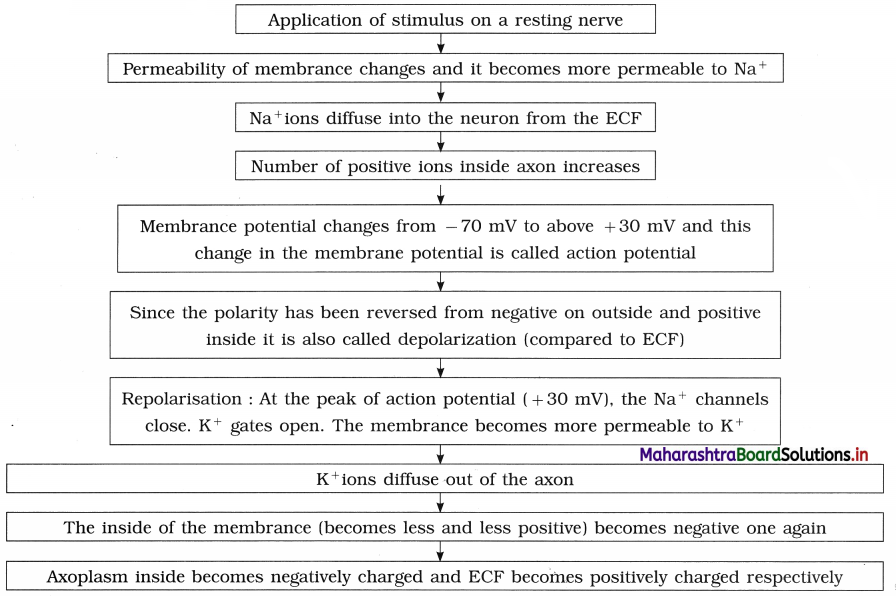
Question 2.
Enlist the names of following cranial nerves: I, II, VII, XII
Answer:
| Number |
NAME |
NATURE |
| I |
Olfactory |
Sensory |
| II |
Optic |
Sensory |
| VII |
Facial |
Mixed |
| XII |
hypoglossal |
Motor |
Question 3.
Enlist the names of following cranial nerves : III, W VI, XI
Answer:
| Number |
NAME |
NATURE |
| III |
Occulomotor |
Motor |
| IV |
Trochlear/Pathetic |
Motor |
| VI |
Abducens |
Motor |
| XI |
Spinal accessory |
Motor |
Question 4.
Complete the table.
| Number |
Type |
No. of Pairs |
Region |
| ———— |
Cervical |
————- |
————— |
| T1 – T12 |
————- |
12 pairs |
————- |
| L1 – L5 |
————- |
5 pairs |
Lower back |
| ————- |
Sacral |
————- |
Pelvic |
| ————– |
Coccygeal |
————— |
Tall region |
Answer:
| Number |
Type |
No. of Pairs |
Region |
| C1 – C8 |
Cervical |
8 pairs |
Neck |
| T1-T12 |
Thoracic |
12 pairs |
Thorax / Upper back |
| L1 -L5 |
Lumber |
5 pairs |
Lower back |
| S – S5 |
Sacral |
5 pairs |
Pelvic |
| Co1 |
Coccygeal |
1 pair |
Tall region |
Question 5.
Write types of neuroglial cells of CNS and PNS in tabular form.
Answer:
| CNS – glial cells |
PNS – glial cells |
Functions |
| Oligodendrocytes [cells with few branches] |
Schwann cells |
Secrete myelin sheath |
| Astrocytes [star-shaped and most abundant glial cells in CNS] |
Satellite cells |
Protect, cushion and supply nutrients to nearby neurons. Help in maintaining blood-brain barrier. |
| Microglia
[small cells with few branches] |
Macrophages |
Phagocytosis |
| Ependymal cells lining the ventricles of brain [mostly columnar] |
Ependymal cells lining central canal of spinal cord |
Secrete cerebrospinal fluid |
Question 6.
Enlist the various receptors found at various location in the body.
Answer:
| Receptors |
Types |
locations |
| Mechanoreceptors |
Thermoreceptors |
Skin |
| Tango [touch and pressure] receptors |
Skin |
| Tactile [light touch] receptors |
Skin |
| Chemoreceptors |
Gustato receptors |
tongue |
| Olfacto receptors |
Olfactory mucosa |
| Photoreceptors |
Rod and cone cells |
Retina of eye |
| Phonoreceptors |
Organ of Corti |
Cochlea of internal ear |
| Stato receptors |
Cristae and maculae |
Semicircular canals, utricle, saccule of internal ear |
Question 7.
Sketch the concept maps for mechanism of vision and mechanism of hearing.
Answer:
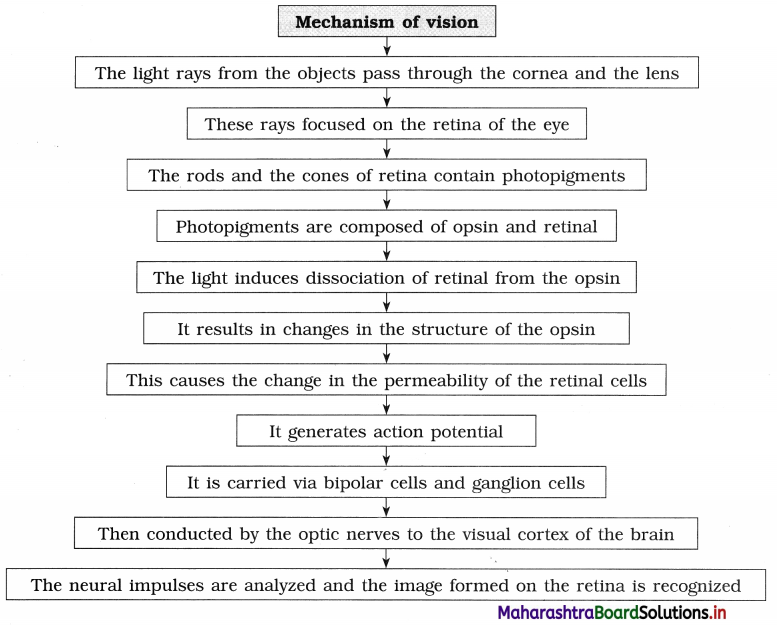
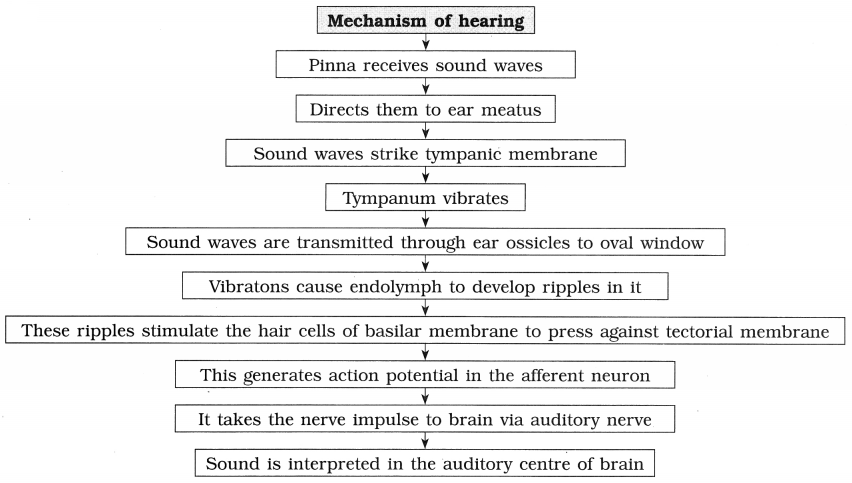
Question 8.
Complete the table given below by putting a tick (✓) in the boxes where applicable.
| Action |
Reflex |
Voluntary |
| 1. Touching a hot object |
———- |
———– |
| 2. Releasing saliva on smelling food |
———– |
———— |
| 3. Applying a car’s brakes in an emergency |
———— |
————– |
| 4. Blinking of eyes when a small insect touches the eye |
———– |
———— |
Answer:
| Action |
Reflex |
Voluntary |
| 1. Touching a hot object |
|
✓ |
| 2. Releasing saliva on smelling food |
✓ |
|
| 3. Applying a car’s brakes in an emergency |
can be a conditioned feclex too. |
✓ |
| 4. Blinking of eyes when a small insect touches the eye |
✓ |
———— |
Question 9.
Complete the following table
| Action |
Reflex |
Voluntary |
| 1. Optic nerve |
———– |
———– |
| 2. Facial |
———– |
———— |
| 3. Hypoglossal |
———— |
————– |
| 4. Trigeminal |
———– |
———— |
| 5. Auditory |
|
|
| 6. Glosso-pharyngeal |
|
|
Answer:
| Action |
Reflex |
Voluntary |
| 1. Optic nerve |
Sensory |
Sense of vision and light |
| 2. Facial |
Mixed |
Facial expression, movement of neck, tongue, etc. and saliva secretion |
| 3. Hypoglossal |
Motor |
Movement of tongue |
| 4. Trigeminal |
Mixed |
Sensation of touch, taste and jaw movements |
| 5. Auditory |
Sensory |
Hearing and equilibrium |
| 6. Glosso-pharyngeal |
Mixed |
Taste, pharyngeal contractions ‘and saliva secretion |
Diagram based questions
Question 1.
Sketch and label – nerve net of Hydra.
Answer:
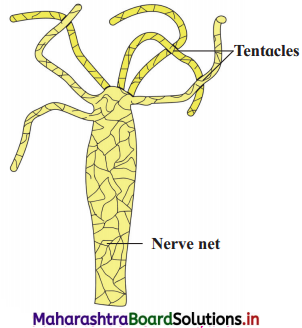
Question 2.
Sketch and label – nervous system of Planaria
Answer:
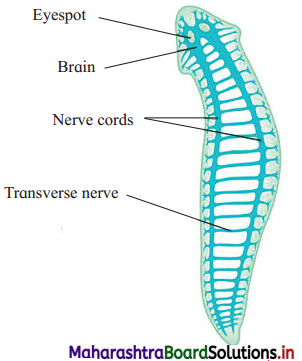
Question 3.
Sketch and label – depolarization and repolarization along nerve.
Answer:
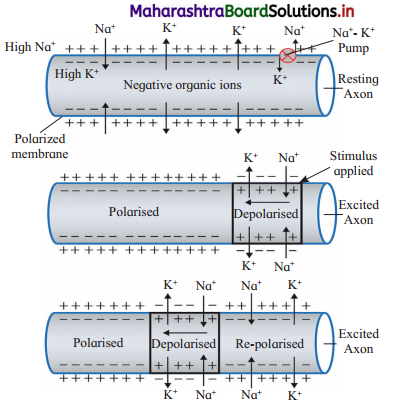
Question 4.
Sketch and label ultrastructure of synapse.
Answer:
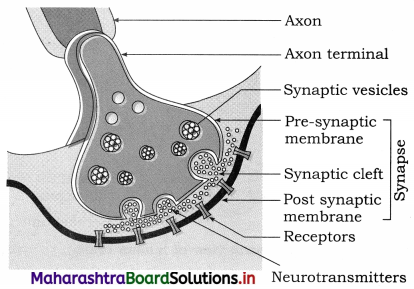
Question 5.
Sketch and label – lateral view of brain.
Answer:


Question 6.
Sketch and label – functional areas of Brain?
Answer:
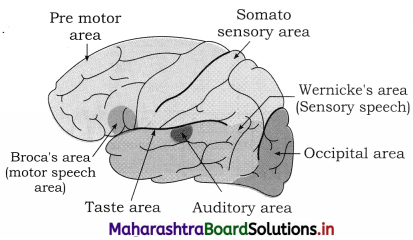
Question 7.
Sketch and label – ventral view of human brain.
Answer:
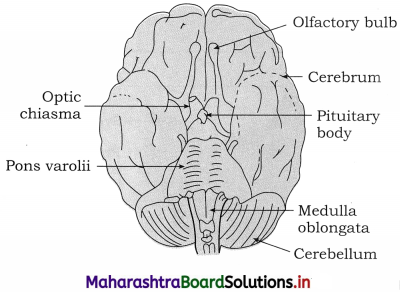
Question 8.
Sketch and label – ventricles of brain.
Answer:
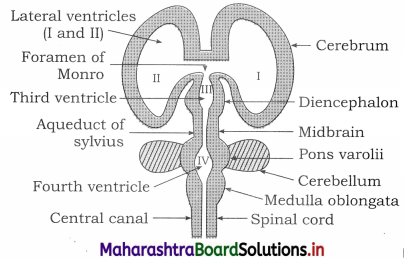
Question 9.
Sketch and label T.S. of spinal cord.
Answer:
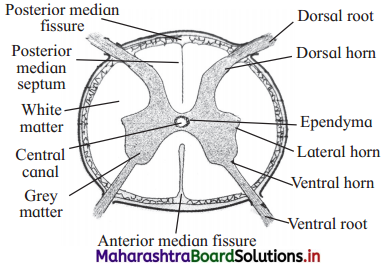
Question 10.
Sketch and label – formation of spinal nerve.
Answer:
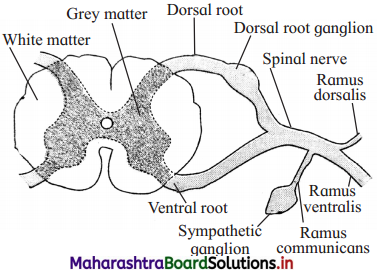
Question 11.
Sketch and label – mechanism of hormone action.
Answer:
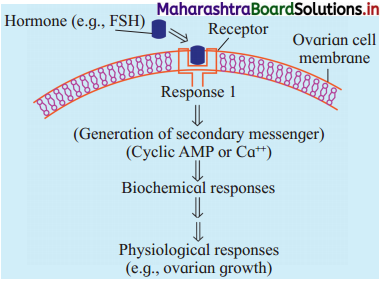

Question 12.
Sketch and label – V.S. of pituitary.
Answer:
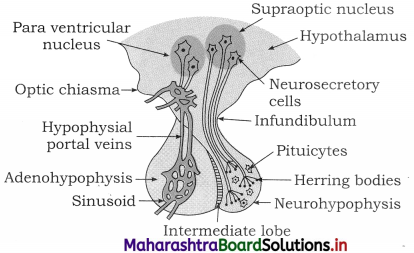
Question 13.
Sketch and label – morphology of thyroid
Answer:

Question 14.
Sketch and label – histology of thyroid
Answer:

Question 15.
Sketch and label – parathyroid glands
Answer:
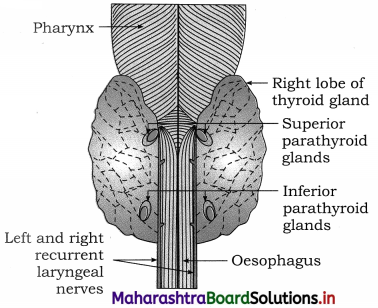
Question 16.
Sketch and label thymus.
Answer:

Question 17.
Sketch and label – adrenal gland.
Answer:
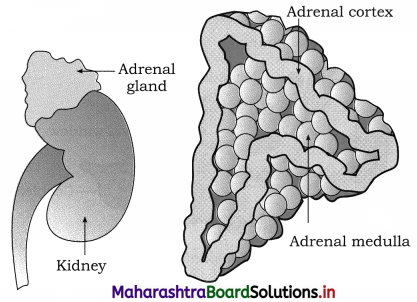
Long answer questions
Question 1.
Explain transmission of nerve impulse across a synapse.
OR
Explain how is impulse transmitted through a synapse?
Answer:
- The nerve impulse travels along the axon of the pre-synaptic neuron to the axon terminal.
- Pre-synaptic neurons or axons have several synaptic knobs at their ends or terminals.
- These knobs have membranous sacs, called synaptic vesicles having neurotransmitter molecules.
- When an impulse reaches a synaptic knob, voltage sensitive Ca++ channels open and calcium ions (Ca++) diffuse inward from the extracellular fluid.
- The increased calcium concentration inside the cells, initiates a series of events that help to fuse the synaptic vesicles with the cell membrane of pre-synaptic neuron, where they release their neurotransmitters by exocytosis.
- The neurotransmitters bind to the receptors of the post-synaptic cell,
- This action is either excitatory (stimulating) or inhibitory (slowing down/stopping).
- Once the impulse has been transferred across the synapse, the enzyme like acetyl cholinesterase destroys the
- neurotransmitter and the synapse is ready to receive a new impulse.
Question 2.
Explain transmission of nerve impulse along the axon.
OR
Describe the conduction of a nerve impulse in the neuron.
Answer:
1. Before conduction of nerve impulse, the cell membrane is in the polarized state.
2. When a stimulus is applied at a site on the polarised membrane, the membrane at that site becomes freely permeable to Na+.
3. This leads to a rapid influx of Na+ followed by the reversal of the polarity at that site, i.e., the outer surface of the membrane becomes negatively charged and the inner side becomes positively charged.
4. The polarity of the membrane at that site [site A] is thus reversed and hence depolarised. The electrical potential difference across the plasma membrane at the site of stimulation is called the action potential, which is in fact termed as a nerve impulse.
5. At sites immediately ahead [site B], the axon membrane has a positive charge on the outer surface and a negative charge on its inner surface. As a result, a current flows on the inner surface from site A to site B.
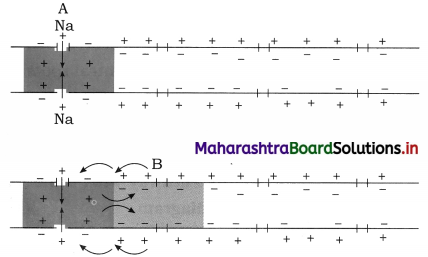
6. On the outer surface current flows from site B to site A to complete the circuit of current flow. Hence, the polarity at the site is reversed, and an action potential is generated at site B. Thus, the impulse (action potential) generated at site A arrives at site B.
7. The sequence is repeated along the length of the axon and consequently the impulse is conducted.
8. The rise in the stimulus-induced permeability to Na+ is extremely short-lived. It is quickly followed by a rise in permeability to K+.
9. Within a fraction of a second, K+ diffuses outside the membrane and restores the resting potential of the membrane at the site of excitation and the fibre becomes once more responsive to further stimulation.

Question 3.
Explain the structure of cerebrum. Structure of cerebrum
Answer:
Answer: Structure of cerebrum:
- Cerebrum is the largest part of the brain. It forms 80-85% volume of the brain.
- A median longitudinal fissure divides the cerebrum into two cerebral hemispheres. These hemispheres are interconnected by a thick band of transverse nerve fibres called corpus callosum.
- The outer part of cerebrum is called cerebral cortex while the inner part is called cerebral medulla.
- The roof of cerebrum is called pallium. Pallium is highly folded forming sulci and gyri. Sulci are depressions while gyrl are ridges. The gyri increase the surface area of cerebral cortex.
- The ventro-lateral walls of cerebrum are thickened and are called corpora striata.
- The cerebral cortex has three deep sulci, the central, lateral and parieto-occipital.
- These sulci divide the cerebral hemisphere into four lobes. These are frontal, parietal, occipital and temporal lobes. A fifth median lobe called insula or insular cortex is folded deep within the lateral sulcus.
- The central sulcus separates frontal and parietal lobes, the lateral sulcus separates parietal and temporal lobes and the parieto¬occipital sulcus separates parietal and occipital lobe.
Question 4.
Describe the structure and function of midbrain.
Answer:
1. Structure of midbrain:
- Midbrain is the middle part of the brain situated between the forebrain and the hindbrain. It is present between the pons varolii and diencephalon.
- It has two distinct regions : Corpora quadrigemina and crura cerebri.
- Corpora quadrigemina consists of two pairs of lobes, viz., superior colliculi and inferior colliculi. These are located in the thick wall of midbrain.
- Crura cerebri are thick bands of longitudinal nerve fibres, present on the floor of midbrain.
2. Functions of midbrain:
- Inferior colliculi control and coordinate auditory reflexes.
- Superior colliculi control head and eye movements.
- Crura cerebri connect the cerebrum to cerebellum and spinal cord.
Question 5.
Give an account of structure of hindbrain.
Answer:
Structure of hindbrain:
- Hindbrain includes cerebellum, pons varolii and medulla oblongata.
- Cerebellum is 11% of the total brain and is the second largest part of the brain.
- It has three lobes, median vermis and lateral two cerebral hemispheres. It has outer grey and inner white matter.
- Cerebral cortex shows sulci and gyri. The inner white matter of cerebellar medulla shows arbor vitae or branching tree-like processes.
- Pons is the part that connects the two cerebral hemispheres. It has outer white and inner grey matter. Pons is made up of nerve fibres which form bridges between cerebrum and medulla oblongata.
- Medulla oblongata is the last part of the hindbrain which continues further as a spinal cord. It has outer white and inner grey matter.
- Its roof shows has posterior choroid plexus.
- Eight pairs of cranial nerves arise from medulla oblongata.
Question 6.
Describe T.S. of spinal cord.
Answer:
- Externally there are three meninges covering spinal cord Duramater, arachnoid membrane and pia mater.
- Dorsoventrally there are two fissures, the shallow dorsal or posterior fissure and the deeper ventral or anterior fissure.
- From dorsal fissure a dorsal septum extends inside.
- Neurocoel or central canal is situated in the centre of spinal cord.
- The central canal is filled with cerebro¬spinal fluid and is lined by cuboidal epithelial cells called layer of ependyma.
- There is inner grey and outer white matter in the spinal cord. This grey matter is in the shape of ‘H’ with two dorsolateral horns and two ventro-lateral horns.
- Dorsal horns form dorsal roots and ventral horns form ventral roots.
- White matter is divided into three columns, viz., the dorsal funiculi, ventral funiculi and lateral funiculi on either side.
- Ascending and descending tracts of nerve fibres arise from dorsal and ventral roots of the spinal cord. Ascending tracts are sensory while descending tracts are motor in nature.
Question 7.
What are the different types of reflexes?
Answer:
1. Based on the location of their action : Thereflexes are divided into somatic reflexes and visceral reflexes.
- When effector is located in body structures such as skeletal muscles, it is called a somatic reflex.
- When the effector is located in the visceral organs such as glands or smooth muscles then it is called a visceral reflex.
2. Based on the basis of number of neurons : Reflexes are of two types, viz. monosynaptic reflexes and polysynaptic reflexes.
- Simple or monosynaptic reflexes are those in which one sensory and one motor neuron are involved in the reflex action.
- Polysynaptic or complex reflexes are those when more than two neurons are involved in the reflex action.
3. Based on inheritance and experience of learning : The reflexes are subdivided into unconditional or inborn and conditional or acquired.
- Unconditional or inborn reflexes are inborn or hereditary. They are permanent, never disappear and need no previous experience, e.g. blinking of eyes, suckling, swallowing, knee jerk, sneezing, coughing, etc.
- Conditional or acquired reflexes are acquired during life by experience or learning. They are based on individual learning or experience. These are not heritable, temporary and may disappear or reappear, e.g. driving, cycling, etc.
Question 8.
Explain the mechanism of reflex action.
Answer:
- Mechanism of reflex action: There are series of sequential events in which reflex action is completed:
- Stimulus is picked up by any receptors, e.g. pricking of a needle in the hand, causes skin to be a receptor.
- Sensory impulse is formed in grey matter of spinal cord. It receives sensory impulse, interprets it and generates motor impulse.
- The cyton of motor neuron present in the ventral horn of grey matter and axon conducts motor impulse from spinal cord to effector organ. This is further carried by dendrites innervating the skin.
- Impulse is carried to the association neuron by axon of sensory neuron, when impulse reaches the end of the axon there is a synapse.
- Transmission takes place by releasing acetylcholine from the synaptic buttons at the end of the axon.
- It fills the synaptic gap and helps in chemical transmission of the impulse from axon of one neuron to dendron of the other neuron. Once the impulse reaches the dendrites of association neuron; axonic button releases an enzyme, acetylcholine esterase which neutralizes the acetylcholine and again a synaptic gap is formed. This mechanism helps to receive new impulse or avoid the mixing of different impulses.
- The association neuron receives sensory impulse, interprets it, analyses it and generates motor impulse. Motor impulse again travels through synapse between association neuron and motor neuron.
- Impulse travels through motor neuron and reaches the effector organ like skeletal muscles or the gland. The effector organ gives a proper response like contraction of the muscles or secretion by the gland.
Question 9.
Define receptors. Enlist different types of receptors.
Answer:
1. Receptors : Receptors are specialized cells, tissues or organs present in the body which receive different stimuli.
2. Types of receptors:
- Receptors are of two types, viz. exteroceptors and interoceptors.-
- Exteroceptors receive stimuli directly from the external environment. They are somatic in nature.
- Interoceptors are located inside the body and are visceral in nature. They respond to internal changes in the body.
- The various types of exteroceptors and interoceptors, their location and functions have been summarized in the table given below:
| Types of Exteroceptors |
Location |
Function |
| 1. Mechanoreceptors |
Touch corpuscles in skin |
Tangoreceptors Pressure Tactile receptors- Touch |
| 2. Thermoreceptors |
Skin |
Frigido receptors (cold) Heat receptors (warmth) |
| 3. Chemoreceptors |
Tongue, nasal mucosa |
Gustatoreceptors – Taste Olfactoreceptors- Smell |
| 4. Statoacoustic receptors |
Internal ear |
Cochlea – Hearing Semicircular canals-Balance and equilibrium |
| 5. Photoreceptors |
Retina of the eye |
Rods and cones interpret images Rods-black and white image. Sensitive to dim light. Cones – Coloured image. Sensitive to bright light. |
Question 10.
Describe the different parts of human eye.
OR
Describe briefly the structure of eye.
Answer:
- Human eyes are a pair of organs located in sockets of the skull called orbits.
- Eyeball is spherical and has three layers.
- Sclera is the outer layer of dense connective tissue with anterior transparent cornea.
- Choroid is the middle layer. It is bluish in colour containing many blood vessels. The anterior region is thick and forms the ciliary body. Posterior 2/3rd region is thinner.
- Iris is the forward segment of the ciliary body which is pigmented and opaque. This part is the visible coloured portion of the eye.
- Lens is present anteriorly inside the iris and is held in position by the ligaments of ciliary body.
- The aperture surrounded by the iris in front of the lens is known as pupil. The movement of the pupil is regulated by the muscle fibres of iris.
- The innermost layer of the eye is the retina having three sub-layers formed by ganglion cells, bipolar cells and photoreceptor cells, which are sensitive to light.
- There are two types of photoreceptor cells, viz. rods and cones containing light sensitive proteins. They are termed as photo pigments, rhodopsin which is a derivative of vitamin A (in rods) and iodopsin (in cones).
- The cones are responsible for daylight or photopic vision and colour vision. The rods function in dim light giving scotopic vision.
- The cones are of three types, each containing its own characteristic photopigments that respond to red, green and blue lights.
- The optic nerve leaves the eye at a point slightly away from the median posterior pole of the eyeball. In this region, the rods and cones are absent therefore this region is known as blind spot. Macula lutea, a yellowish pigmented spot is present lateral to the blind spot.
- Fovea is a central pit present beside it. Fovea is a thinned out portion of the retina where only the cones are densely packed and therefore have greatest visual acuity (resolution).
- A space between the cornea and the lens is called aqueous chamber. It contains a thin watery fluid known as aqueous humor.
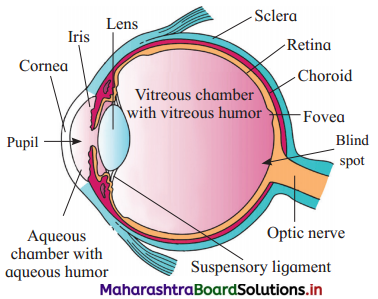
Question 11.
Describe the internal structure of human ear.
OR
Ear is one of the important sense organs known for its role in hearing and balancing. Describe those structures present in the internal ear which helps in these functions.
Answer:
- The ears are the auditory sensory organs, also involved in maintaining equilibrium of the body.
- The ear is composed of three divisions namely the outer ear, middle ear and internal ear.
- The external ear consists of the pinna and external auditory meatus (canal). The pinna is for the collection of sound waves coming from the environment. The external auditory canal is the circular tube leading inside up to the eardrum or tympanic membrane.
- The tympanic membrane or eardrum is formed of connective tissues having outer skin cover and inner mucus membrane.
- The middle ear consists of chain of three ossicles called malleus, incus and stapes, The malleus is attached to the tympanic membrane and the stapes is connected to the oval window of the internal ear. They help in the transmission of sound waves from external auditory canal to internal ear.
- Connecting middle ear with the pharynx is eustachian tube which helps in equalizing the air pressure on either side of the tympanic membrane.
- The internal ear is fluid filled structure called labyrinth. It has two parts, bony and the membranous labyrinth.
- The outer bony labyrinth is formed by the series of channels in which the membranous abyrinth containing endolymph fluid is present.
- The membranes consist of coiled cochlea, the reissner’s membrane and basilar membranes. These membranes divide the surrounding perilymph filled bony labyrinth into an upper scala vestibule and a lower scala tympani.
- The space within cochlea which is known as scala media is filled with endolymph. The scala vestibule ends at the oval window at the base of cochlea.
- The scala tympani terminates at the round window which opens to the middle ear. The organ of corti is located on the basilar membrane. It contains the hair cells which act as auditory receptors.
- The hair cells are columnar cells present in rows. The basal ends of the hair cells are in close contact with the afferent nerve fibres while their apical end contains numerous cilia. A thin elastic membrane projects above the rows of the hair cells called tectorial membrane.
- Above the cochlea, the internal ear also contains vestibular apparatus. It consists of three semicircular canals and the otolith organ formed of the sacculus and utriculus. The semicircular canals lie in different plane at right angles to each other and are suspended in the perilymph.
- The bases of canals are swollen and are called ampullae, which contain a projecting ridge known as crista ampullaris which contain hair cells.
- The sacculus and utriculus also have projecting ridge called macula. The crista and macula are the specific receptors of vestibular apparatus. They are responsible for maintenance of body posture and the balance.

Question 12.
Write an account of position and structure of pituitary gland.
Answer:
Pituitary gland (Hypophysis):
I. Position : Pituitary or Hypophysis is located on the ventral side of brain below the hypothalamus. Infundibulum or hypophyseal stalk attaches pituitary to hypothalamus just behind the optic chiasma. It is well protected in sella turcica which is a depression of the sphenoid bone of the skull.
II. Morphological structure of pituitary- gland: The pituitary gland shows two distinct regions : Anterior lobe or adenohypophysis and posteriorlobe or neuro-hypophysis.
(1) Adenohypophysis or Anterior lobe : It is the largest lobe of the gland and forms about 75% of pituitary gland. It develops as an outgrowth called Rathke’s pouch from the roof of embryonic buccal cavity. It has three divisions, viz. pars tuberalis, pars distalis and pars intermedia.
(i) Pars tuberalis : Tubular region present below the hypothalamus is known as pars tuberalis. It is like a collar around the infundibulum. It is non-secretory in nature.
(ii) Pars distalis : The largest anterior region which is secretory in nature is called pars distalis. It is made up of loose cords of epitheloid secretory cells which are separated by reticular connective tissue containing blood sinusoids. It is connected to the hypothalamus by portal system formed by blood sinusoids.
(iii) Pars intermedia : The narrow cleft between the pars distalis and pars nervosa of neuro – hypophysis is called the intermediate part or pars intermedia. It is reduced, less developed and non-functional in human being.
(2) Neuro-hypophysis or Posterior lobe : The posterior lobe of the pituitary which is attached to hypothalamus by infundibular stalk is called neuro-hypophysis. It is smaller and constitute 25% of pituitary. It has the following three parts:
- Median eminence : The swollen median part of the hypothalamus where infundibulum gets attached is called median eminence.
- Infundibulum : Infundibulum is the hypophyseal stalk that helps in attachment of pituitary gland to the hypothalamus. It contains mainly the axonic fibres of neurosecretory cells present in hypothalamus. It forms the major connection of hypothalamo-hypophysis axis.
- Pars nervosa : The lowermost, larger region of neuro-hypophysis that contains axons is called pars nervosa. It acts as a neurohaerhal organ and contains specialized cells called pituicytes.

Question 13.
In a person, Pars distalis part of the Pituitary gland is not producing hormones in sufficient quantity. Explain the effects it will produce with respect to the different hormones.
OR
Give names and functions of hormones secreted by adenohypophysis.
Answer:
Pars distalis of the pituitary gland produces following hormones:
GH, ACTH, TSH, FSH, LH/ICSH, LTH and MSH. If these hormones are produced in deficient quantities, following disorders are seen.
1. GH:
(a) Hyposecretion of GH in childhood leads to dwarfism. Frohlich dwarf or Lorain dwarf may be produced based on mental capacity. Hyposecretion in adulthood causes Simmonds’s disease.
(b) Hypersecretion of GH in childhood causes gigantism and in adulthood it causes acromegaly.
2. TSH :
(a) Hyposecretion of TSH leads to thyroid atrophy.
(b) Hypersecretion of TSH causes excessive functioning of thyroid gland.
3. ACTH :
(a) Hyposecretion of ACTH causes Addisons’ disease, in which adrenal gland shows failure of functions.
(b) Hypersecretion of ACTH causes Cushing’s disease, in which the adrenal cortex undergoes excessive growth.
4. FSH : Hyposecretion of FSH leads to infertility in both the sexes. Hypersecretion of FSH in females cause disturbances in menstrual cycle.
5. LH/ICSH : Hyposecretion of LH in females will cause lack of ovulation. Hyposecretion of ICSH in males cause reduction in masculinity. Sperm production may be affected. Hypersecretion of LH/ICSH can cause disturbances in reproductive cycles.
6. LTH : Corpus luteum is not maintained due to lesser amount of LTH. Lactogenesis will also hamper if there is hyposecretion of LTH.
Question 14.
Describe the hormones of neuro¬hypophysis.
Answer:
Hormones of neuro-hypophysis : Neuro-hypophysis does not secrete any hormone itself but stores the hormones which are secreted by hypothalamic neurons. It stores and releases the following hormones, viz. ADH, Oxytocin and coherin.
1. Anti Diuretic Hormone (ADH) or Vasopressin:
- ADH brings about anti-diuretic action and also increases blood pressure.
- It is a regulatory hormone which plays a major role in osmoregulation.
- It increases the permeability of distal convoluted tubule or collecting tubules of uriniferous tubules of kidney.
- Higher ADH levels decrease the urine output and helps for water conservation. It helps in the absorption of water from the ultrafiltrate thus regulates the water balance of body fluids.
- ADH also controls constriction of arterioles and increases blood pressure in kidney which facilitates ultra filtration. Therefore it is also called vasopressin.
- ADH is regulated by increase or decrease of osmotic pressure of blood in a feedback manner.
- The osmotic pressure is detected by osmoreceptors in the hypothalamus.
2. Oxytocin (Birth hormone):
- Oxytocin helps in parturition.
- It is a powerful stimulant of contraction of uterine myometrium at the end of gestation due to which the labour is initiated.
- It also stimulates myoepithelial cells of mammary glands for milk ejection during lactation.
- It also helps in fertilization by powerful contractions of the uterine musculature to drive the sperms upward towards fallopian tubes.
- Oxytocin also excites musculature of gallbladder, ureters, urinary bladder, intestine, etc. for proper functioning of these organs.
3. Coherin : Coherin induces prolonged, rhythmic integrated contractions of the jejunum.
Question 15.
Describe the morphology of thyroid gland.
Or
With the help of a suitable diagram describe the structure of thyroid gland.
Answer:
Morphology of thyroid gland:
- Thyroid is the largest endocrine gland in the body.
- It weighs about 25 to 30 g and measures about 5 cm in length and 3 cm in width.
- It is located in the neck region anteriorly just below the larynx and situated ventrolaterally to the trachea.
- The thyroid is derived from the endoderm of the embryo.
- The thyroid can vary in size as per age, sex and diet.
- It is reddish brown, bilobed and highly vascular
- The two lobes are joined by connective tissue called isthmus which is located at 2nd to 4th tracheal cartilage.
- Therefore, the right and left lobe of thyroid are seen on both sides of the trachea.
- The gland is H-shaped having butterfly-like appearance.
- The structural and functional units of thyroid gland are the thyroid follicles.
- From the outer surface there lies a connective tissue capsule. A number of septa arise from the connective tissue which are called trabeculae. They divide the gland into lobules. Each lobule has follicles which store hormone. The number of follicles are about three million.
Question 16.
Describe neurohormonal regulation of pituitary and thyroid gland.
Answer:
Pituitary gland is directly under the influence of neurohormones of hypothalamus while thyroid is indirectly influenced.
I. Neurohormonal regulation of pituitary:
- Hypothalamus secretes releasing factors and inhibiting factors and hence regulate the secretions of pituitary (hypophysis).
- Hypothalamus forms the hypothalamohypophysial axis through which transportation of neuro-hormones take place.
- Pituitary secretes a variety of hormones which influence other endocrine glands of the body. E.g. GH, PRL, TSH, ACTH, Gonadotropins
II. Neurohormonal regulation of thyroid :
- Hypothalamus secretes TRF [Thyrotropin releasing factor] which influences the anterior pituitary to release TSH.
- TSH in turn stimulates thyroid follicles to produce and release two thyroid hormones – T3 and T4. (Thyroxin)
- Increase in T3 and T4 triggers negative feedback mechanism that stops the secretion of TRF.
(4) As the pituitary does not get the signal in the form of TRF TSH secretion is stopped.
Question 17.
Name the hormones secreted by the adrenal cortex and state their role.
Answer:
Adrenal cortex secretes 3 types of corticoids – mineralocorticoids, glucocorticoids and sex corticoids.
I. Mineralocorticoids:
- The mineralocorticoids regulate ionic and osmotic balance, by regulating the amounts of electrolyte and water.
- Aldosterone is the main mineralocorticoid that acts on the renal tubules.
- Aldosterone stimulates the re-absorption of Na+ and water and excretion of K+ and phosphate ions.
- The aldosterone helps in the maintenance of electrolytes, body fluid volume, osmotic pressure and blood pressure.
II. Glucocorticoids:
- Cortisol is the main glucocorticoid. Cortisol stimulates many metabolic reactions such as gluconeogenesis, lipolysis and proteinolysis.
- It inhibits cellular uptake and utilization of amino acids.
- Cortisol also plays an important role in maintaining the cardiovascular system and kidney functions.
- It is also involved in anti-inflammatory reactions and suppresses the immune response.
- Cortisol stimulates the RBC production.
III. Sex corticoids (Gonadocorticoids).
- Sex corticoids, Androgens and estradiols are produced by the adrenal cortex.
- In males, they have a role in development and maintenance of external sex characters.
- Excess sex corticoids in female causes adrenal virilism and hirsutism (excess hair on face)
- Excess sex corticoids in males causes gynaecomastia i.e. enlarged breast.
![]()
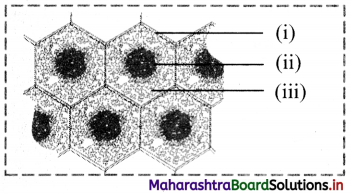
![]()
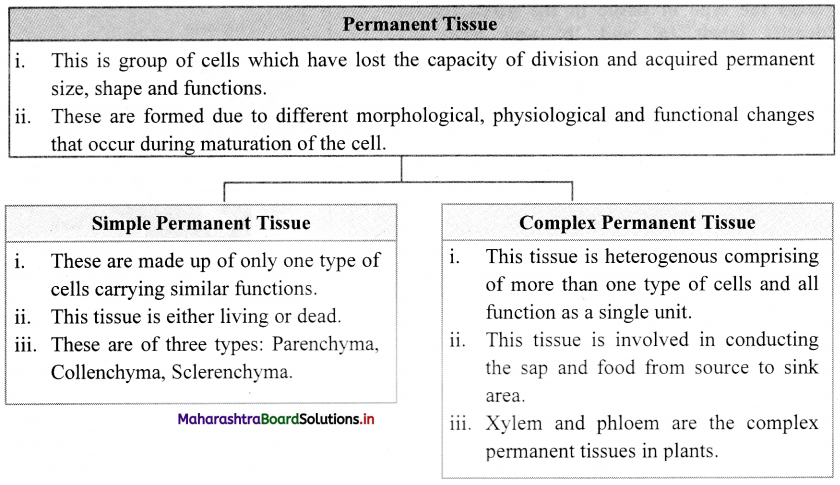

![]()
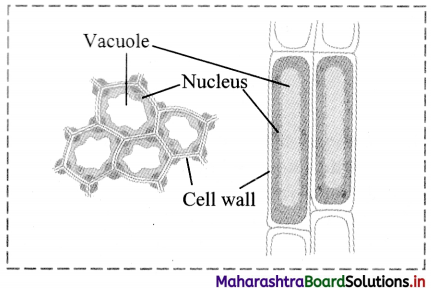
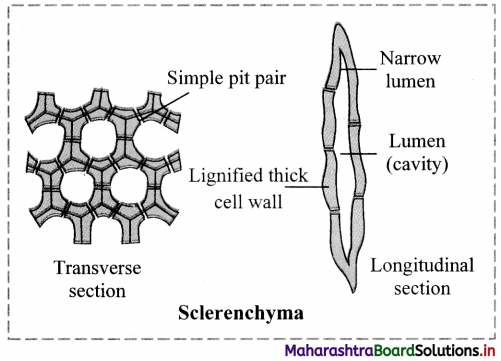
![]()
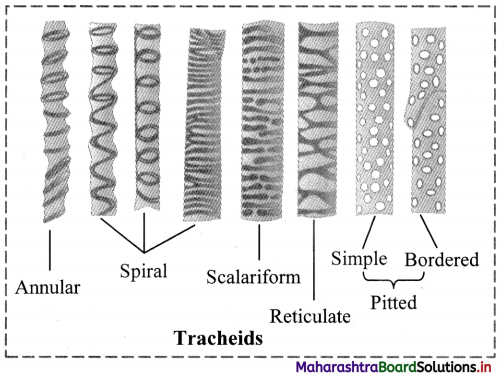
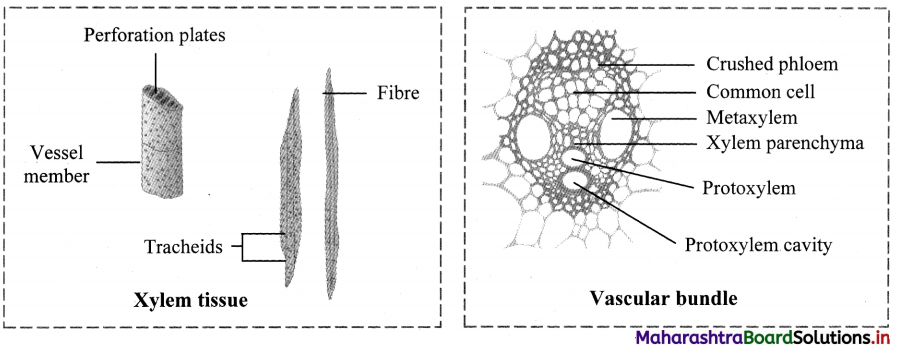
![]()
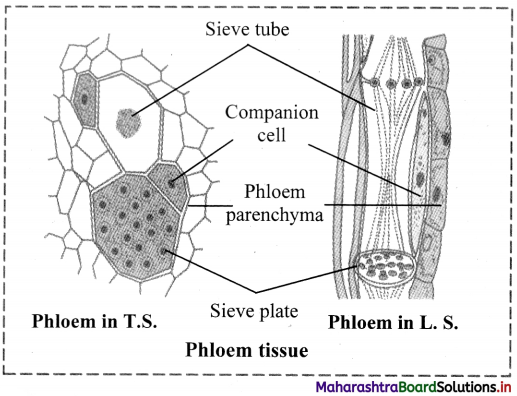
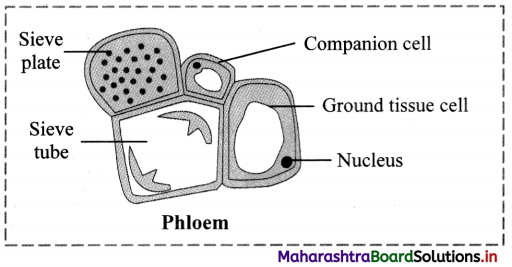
![]()

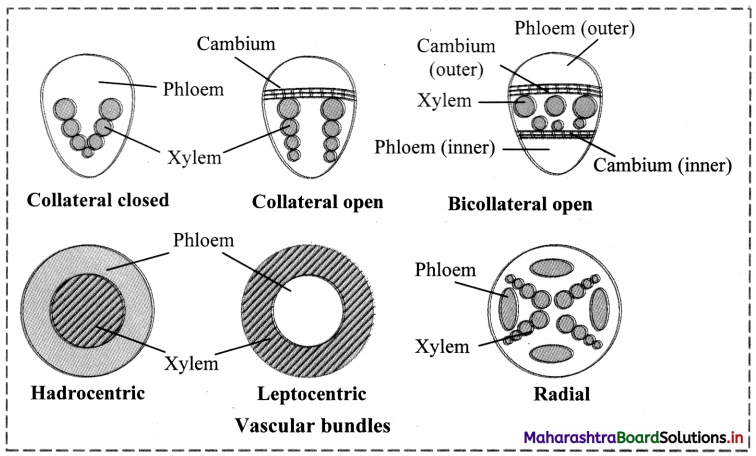
![]()
![]()
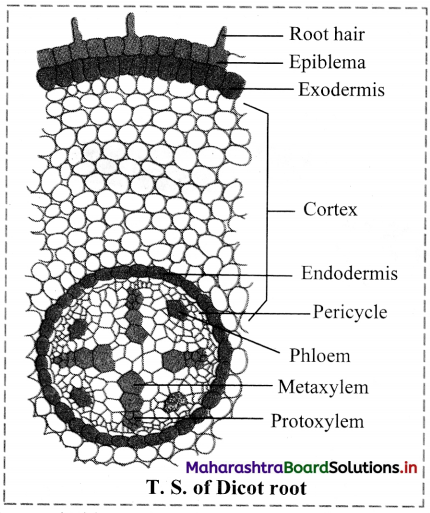
![]()
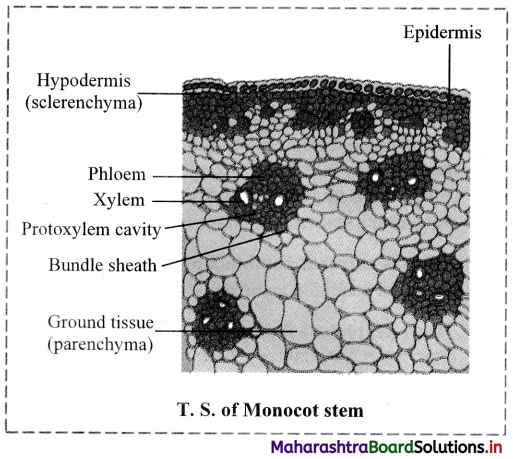
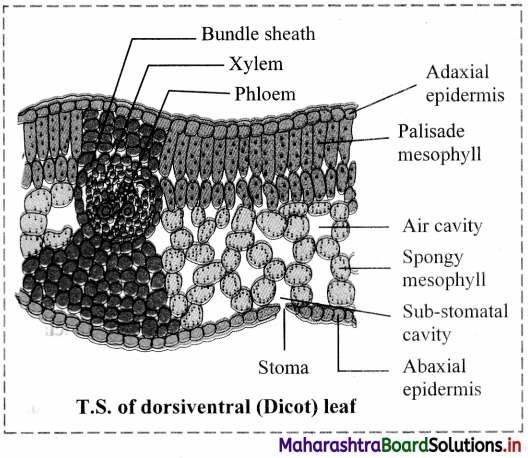
![]()
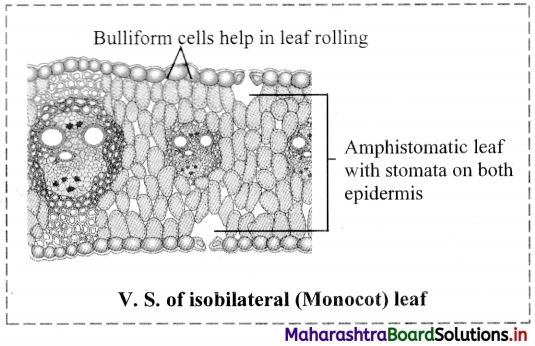
![]()
![]()
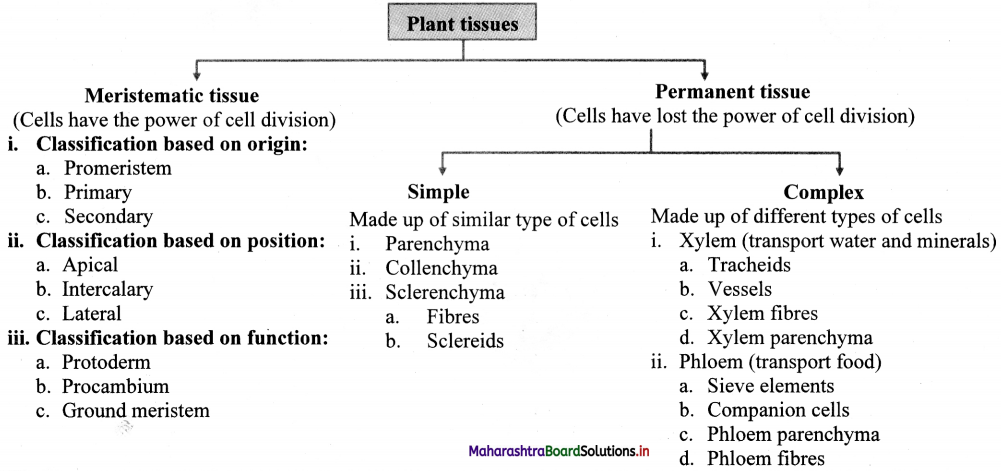

![]()
![]()
![]()
![]()
![]()
![]()
![]()
![]()
![]()
![]()
![]()
![]()
![]()
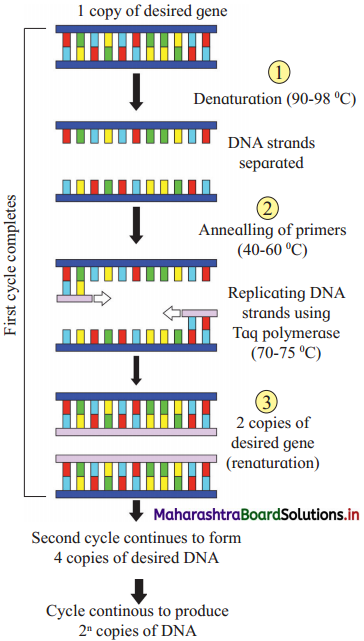
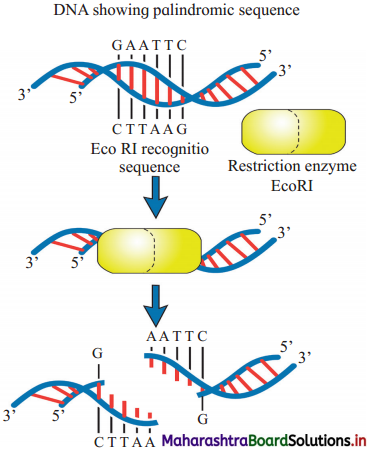
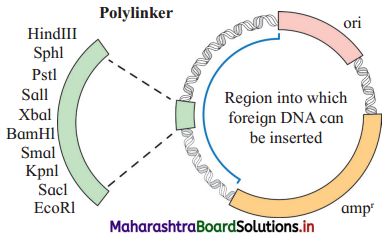
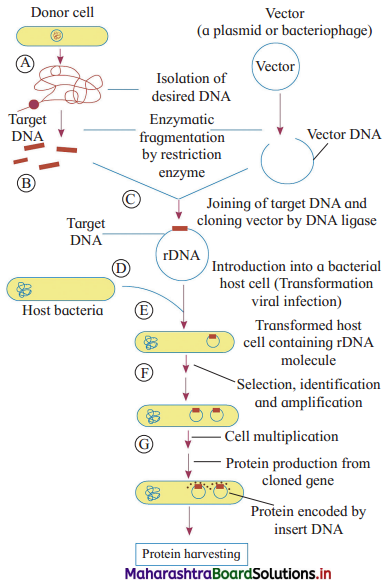
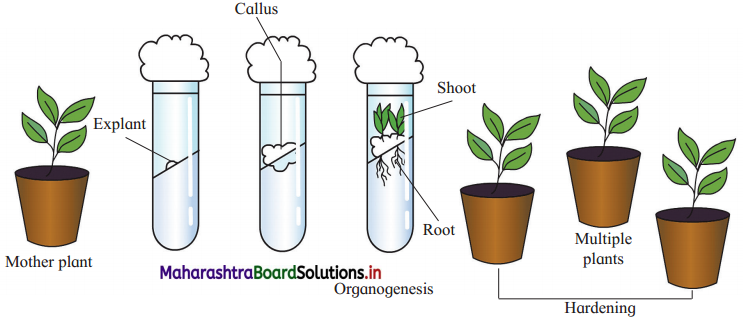
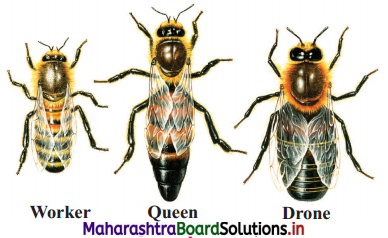
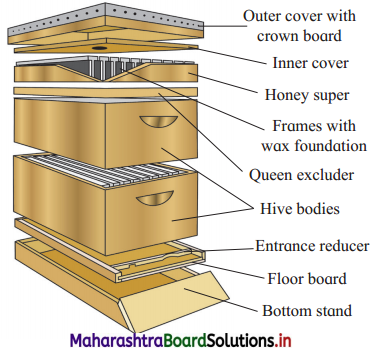
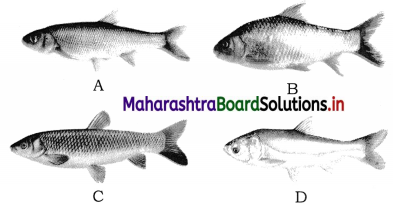

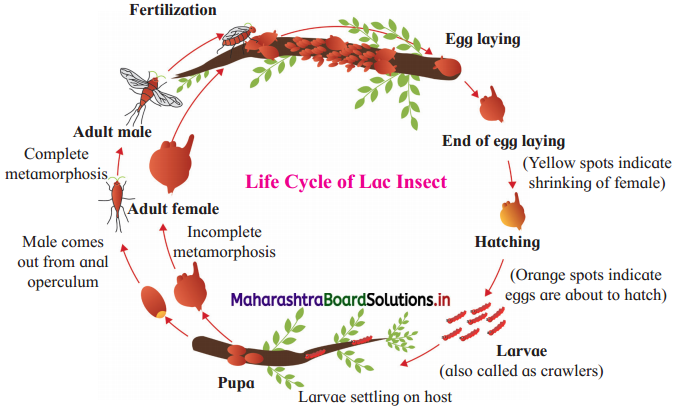
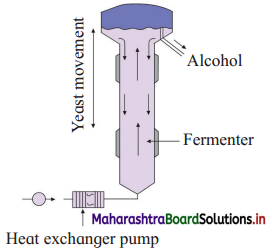
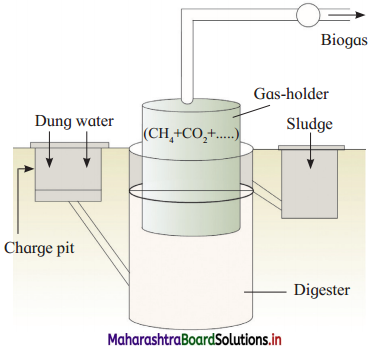
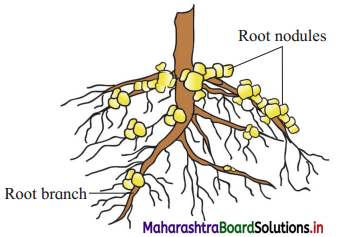

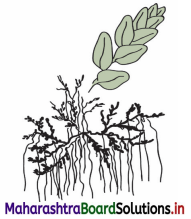
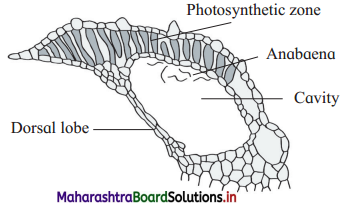

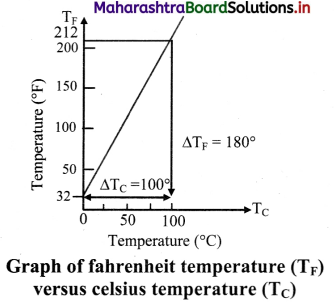
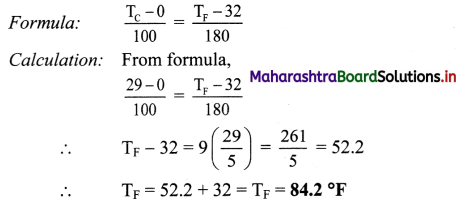
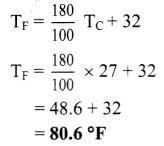
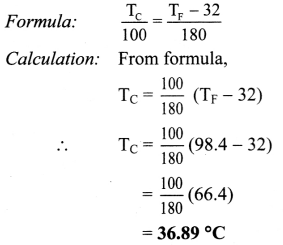
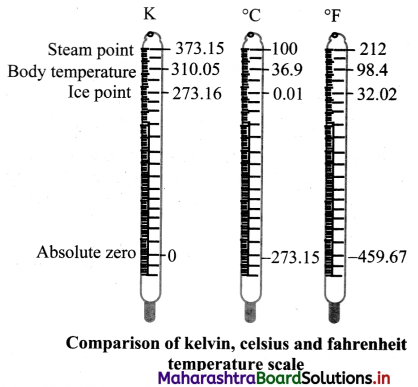
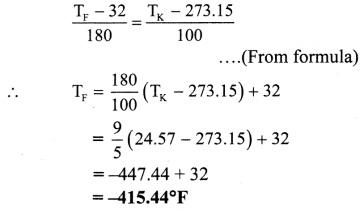


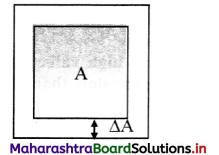
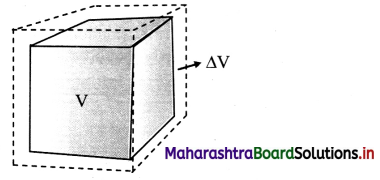


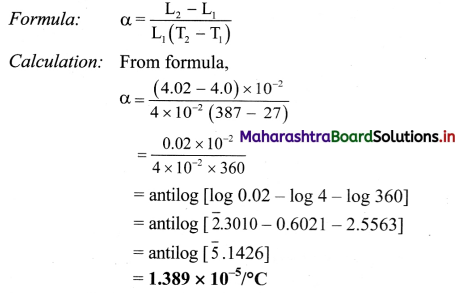
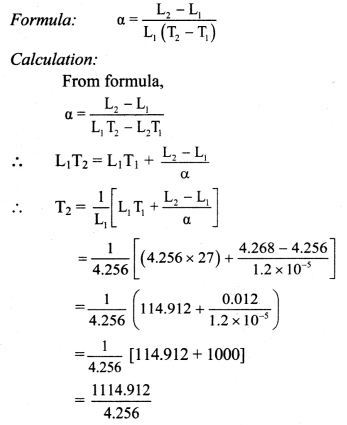

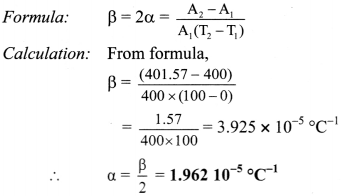
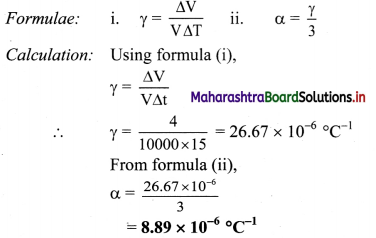



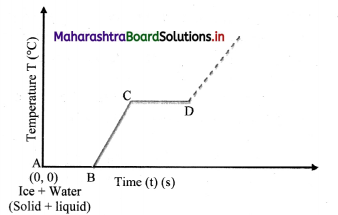

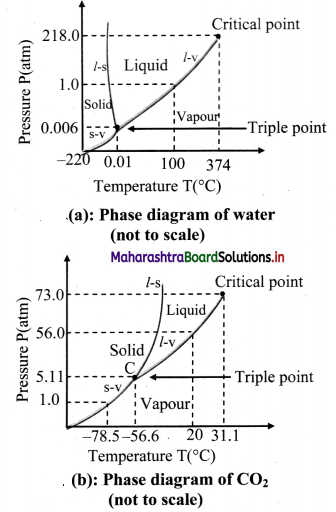



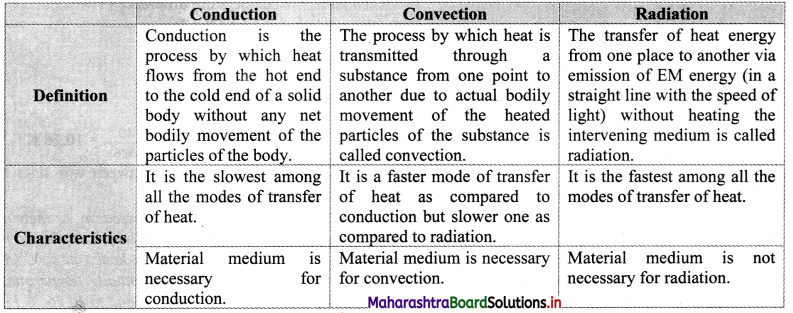

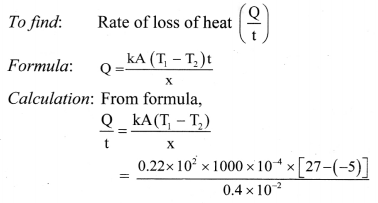
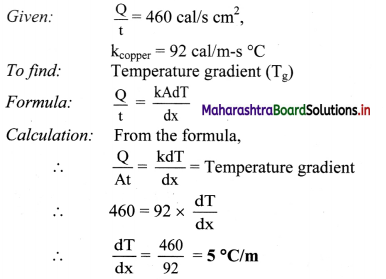

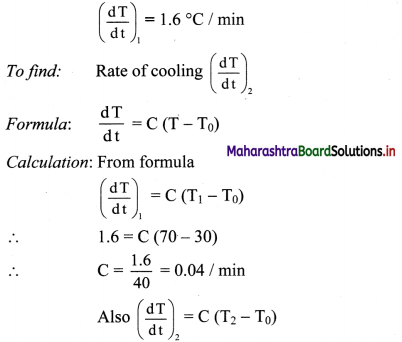
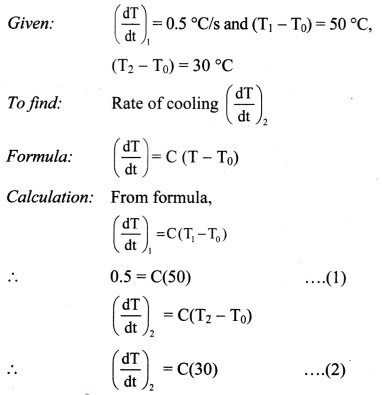
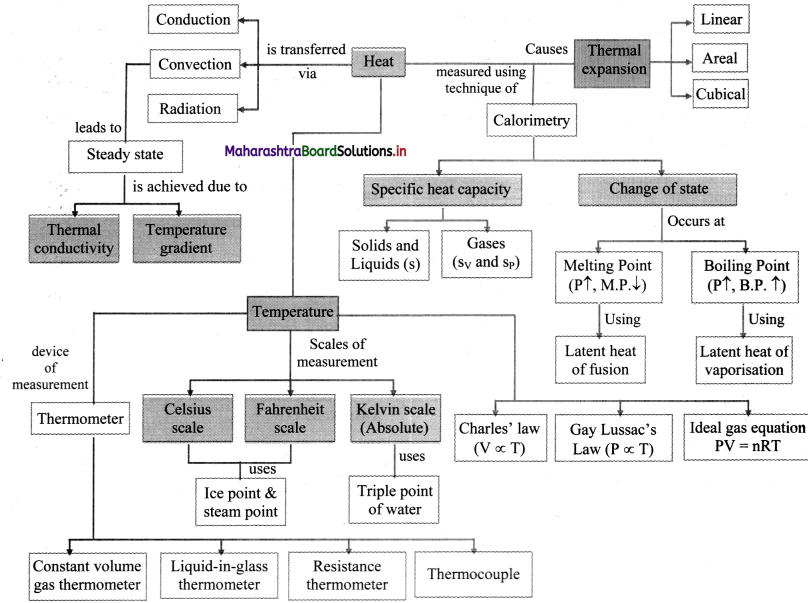
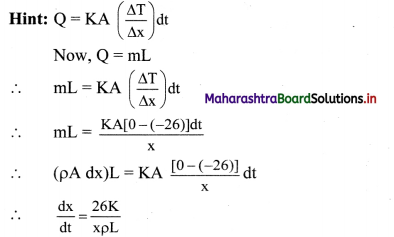
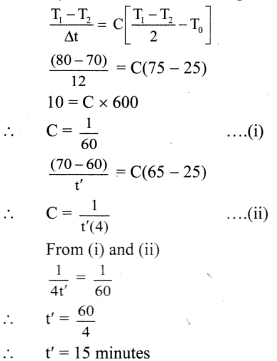
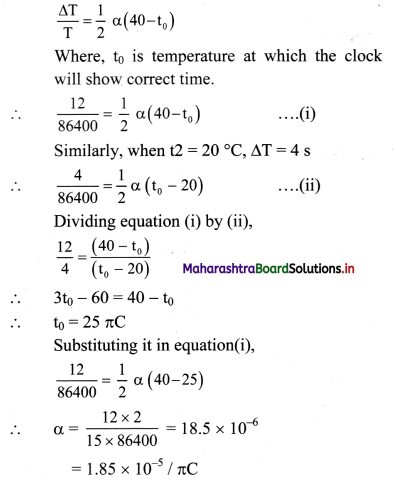
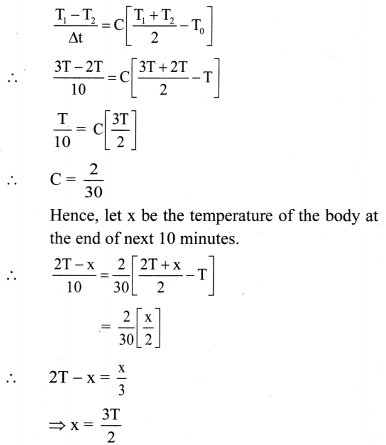
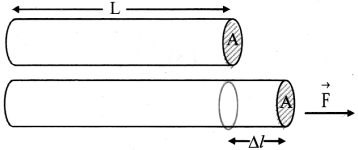



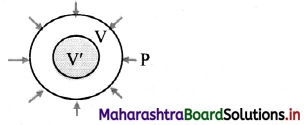
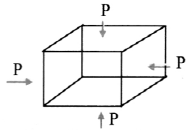

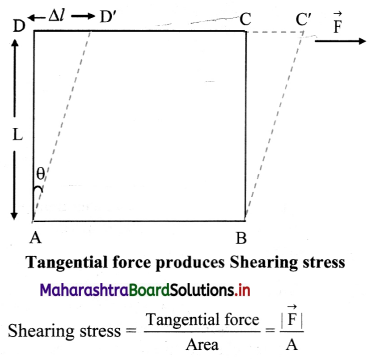




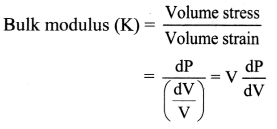
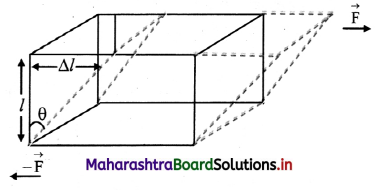
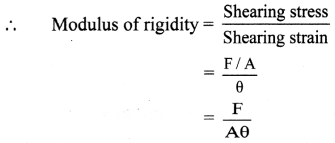



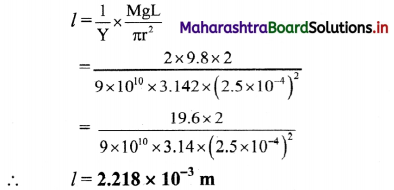

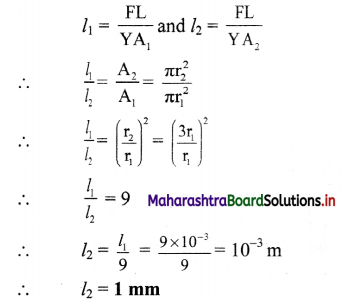
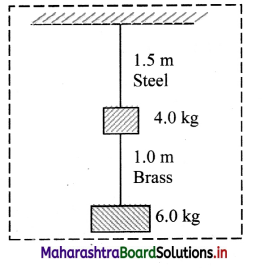
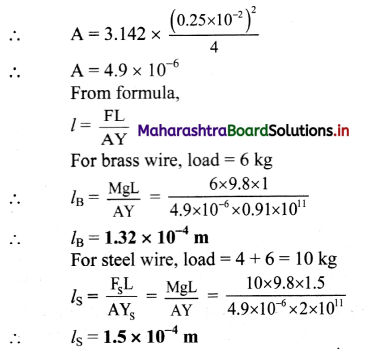
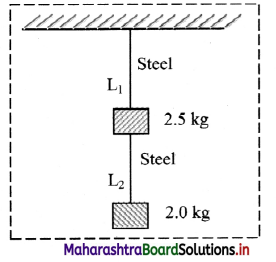
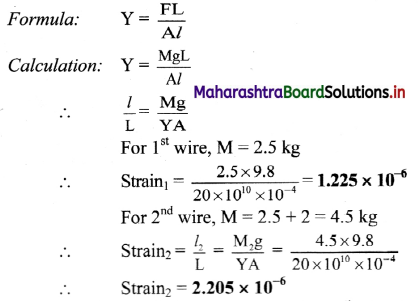
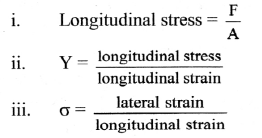

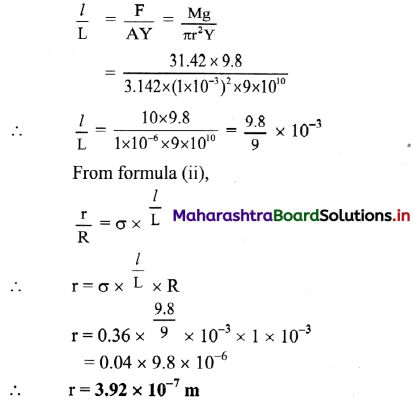


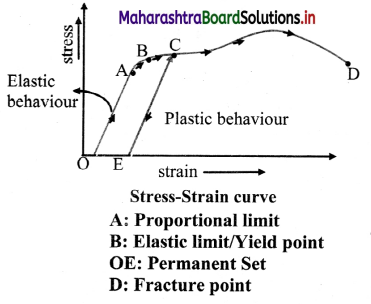
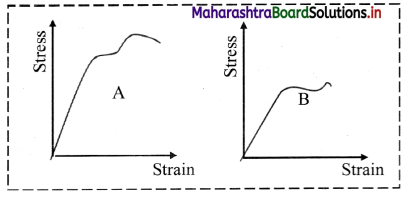

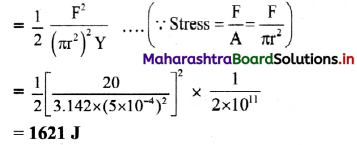
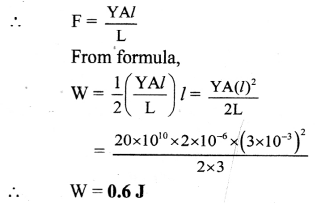
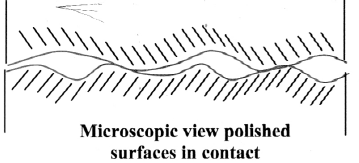




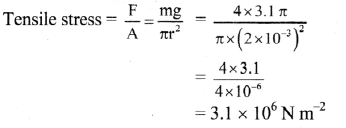

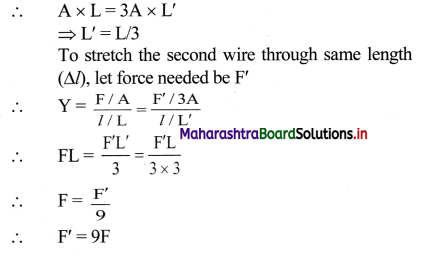
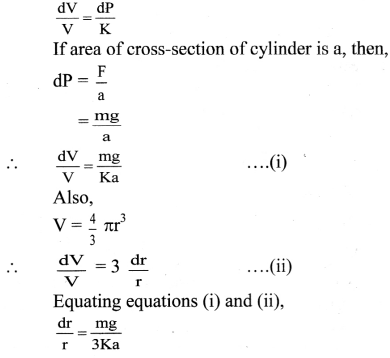

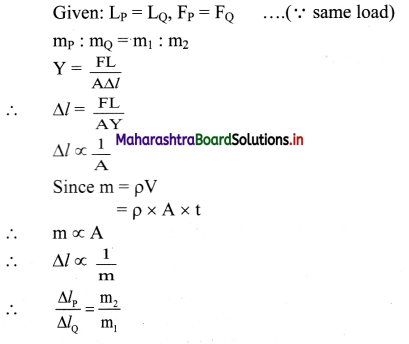

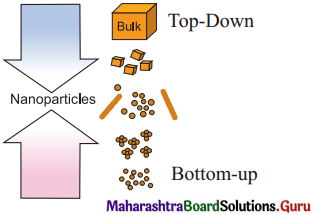
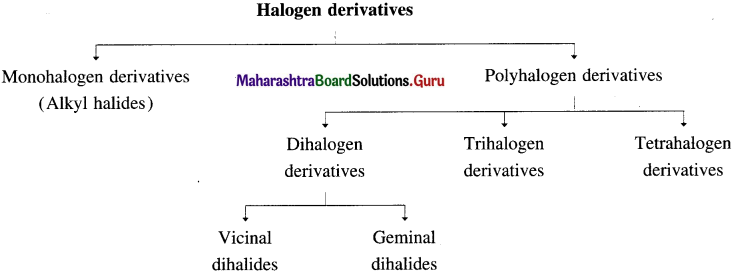

 (Two halogen atoms on vicinal or adjacent carbon atoms)
(Two halogen atoms on vicinal or adjacent carbon atoms)


 (R and R’ can be same or different)
(R and R’ can be same or different)
 (R, R’ and R” may be same or different)
(R, R’ and R” may be same or different)



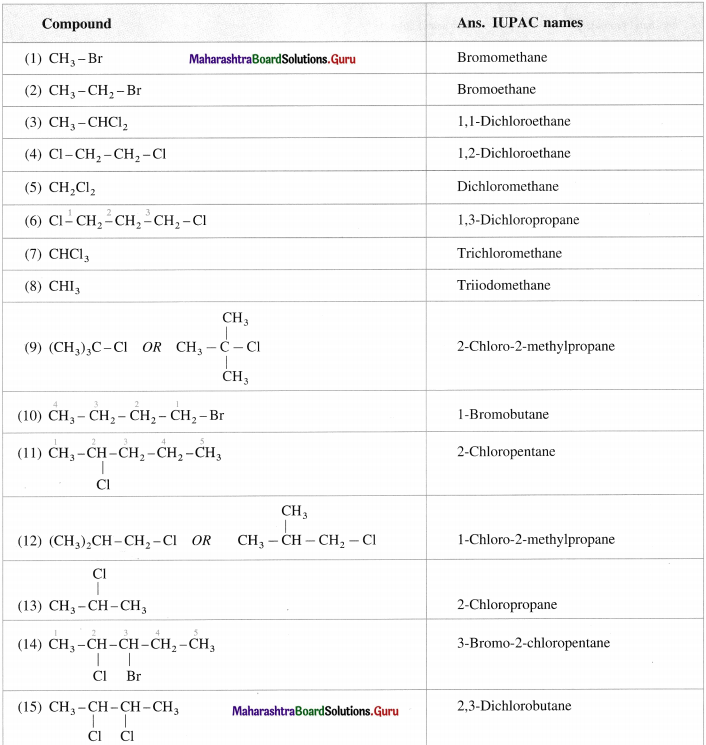
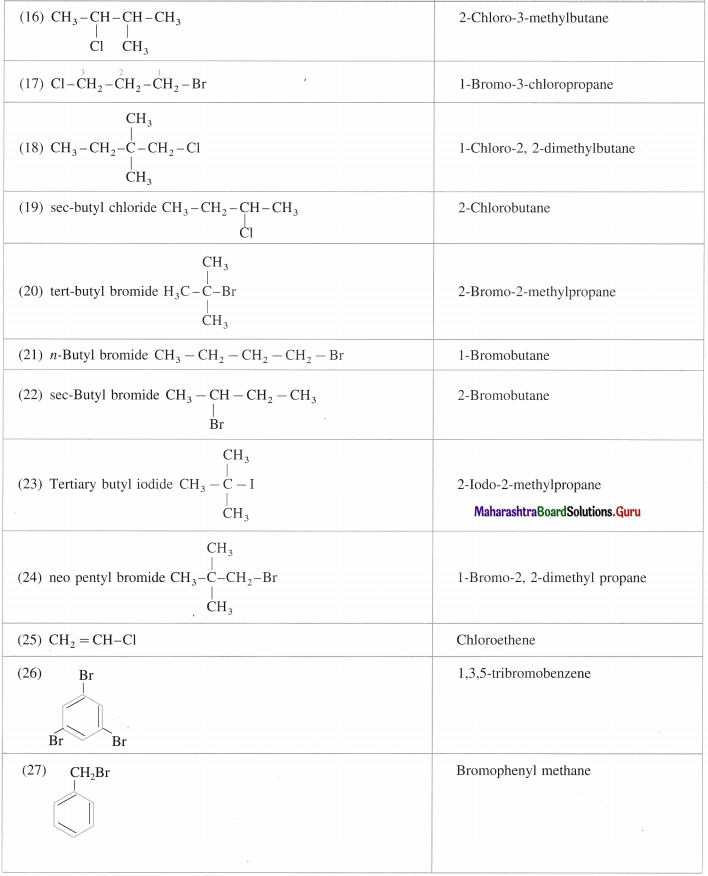
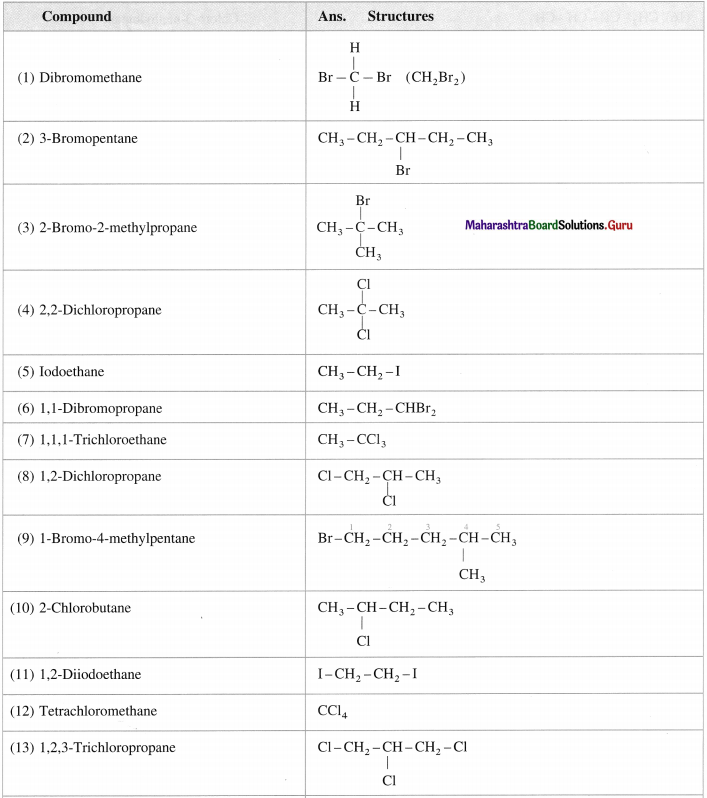

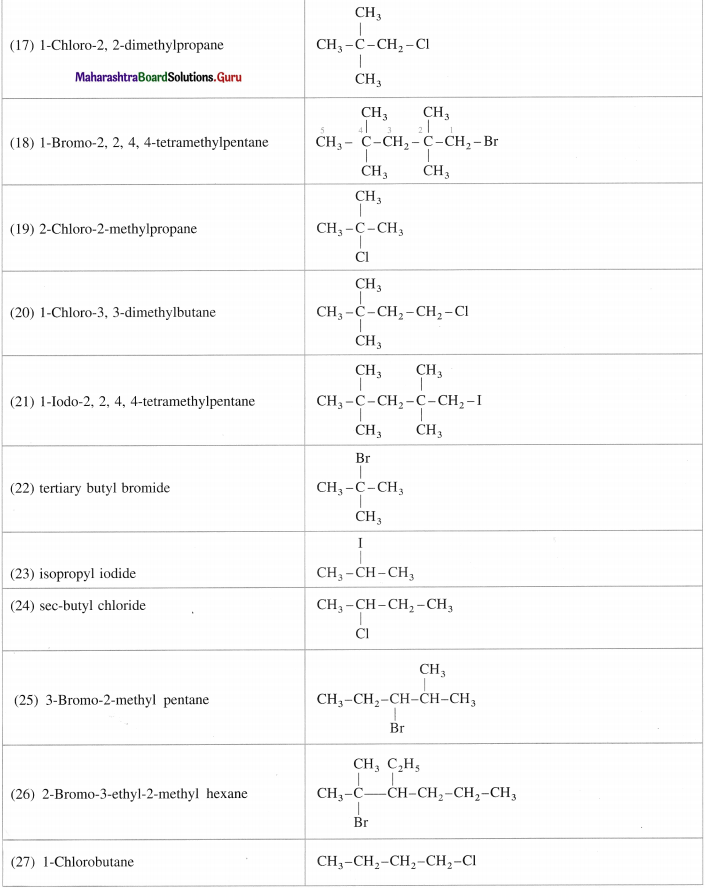


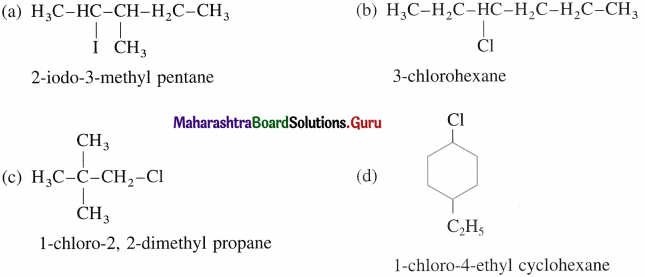
























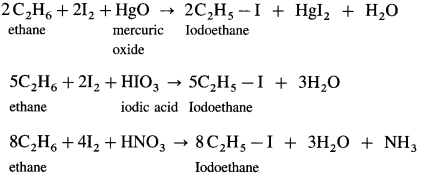






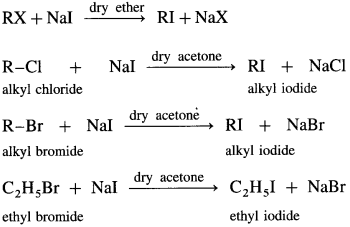
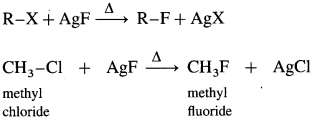



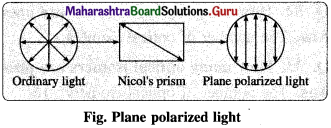
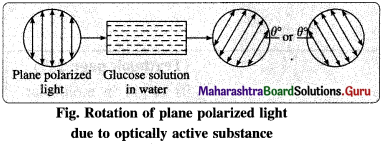

 the starred carbon atom is chiral carbon atom as it is attached to four different substituents, COOH, OH, CH3 and H.
the starred carbon atom is chiral carbon atom as it is attached to four different substituents, COOH, OH, CH3 and H. the starred carbon atom is chiral carbon atom as it is attached to four different substituents, -CH2 – CH3 (ethyl), CH3 (methyl), Cl and H.
the starred carbon atom is chiral carbon atom as it is attached to four different substituents, -CH2 – CH3 (ethyl), CH3 (methyl), Cl and H.
